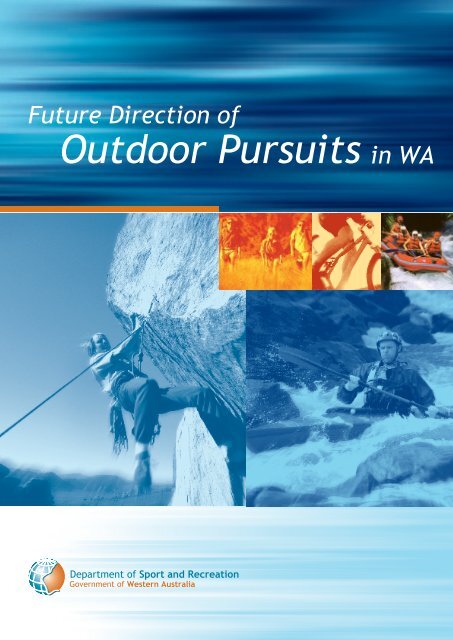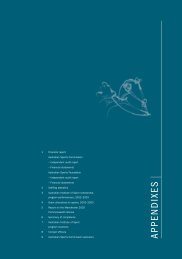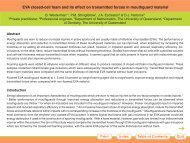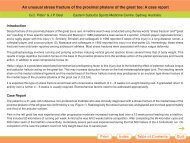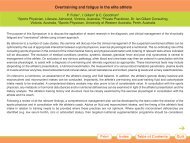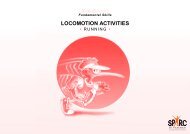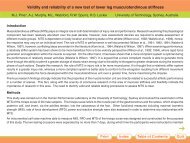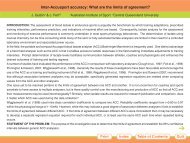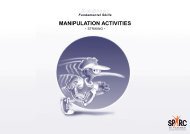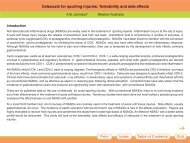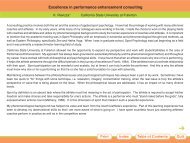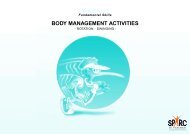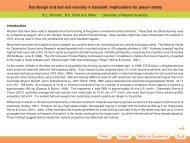Future Direction of Outdoor Pursuits in WA - Australian Sports ...
Future Direction of Outdoor Pursuits in WA - Australian Sports ...
Future Direction of Outdoor Pursuits in WA - Australian Sports ...
Create successful ePaper yourself
Turn your PDF publications into a flip-book with our unique Google optimized e-Paper software.
<strong>Future</strong> <strong>Direction</strong> <strong>of</strong><br />
<strong>Outdoor</strong> <strong>Pursuits</strong> <strong>in</strong> <strong>WA</strong>
Acknowlegements<br />
In appreciation <strong>of</strong> the contribution and patience <strong>of</strong> the many <strong>in</strong>dividuals and<br />
stakeholder groups support<strong>in</strong>g the development <strong>of</strong> these future directions for<br />
outdoor pursuits <strong>in</strong> Western Australia.<br />
Thank you to the follow<strong>in</strong>g Reference Group members for their contribution,<br />
particularly with<strong>in</strong> the early deliberations <strong>in</strong> the formation <strong>of</strong> this report: Len Pavy<br />
(Chair), Dave Boldy, David Byers, Sarah Fletcher, Simon Hanson, Terry Hewett,<br />
Bert O’Meagher, Rohan Swan, Mark Tait and Peter Nidd (Executive support).<br />
ISBN: 0-9585960-2-6<br />
© Department <strong>of</strong> Sport and Recreation, December 2002<br />
Perry Lakes Stadium, Meagher Drive, Floreat<br />
PO Box 66, Wembley, Western Australia 6913<br />
Phone: (08) 9387 9700 Fax: (08) 9387 9726 Email: <strong>in</strong>fo@dsr.wa.gov.au<br />
<strong>Future</strong> <strong>Direction</strong> <strong>of</strong> <strong>Outdoor</strong> <strong>Pursuits</strong> <strong>in</strong> <strong>WA</strong><br />
3
4<br />
Contents<br />
Executive Summary .................................................................................... 5<br />
1 Terms <strong>of</strong> Reference and Methodology .................................................. 9<br />
2 <strong>Outdoor</strong> <strong>Pursuits</strong>: An Overview ........................................................... 11<br />
Def<strong>in</strong>ition ................................................................................................ 11<br />
What characterises outdoor pursuits? ..................................................... 11<br />
Trends <strong>in</strong> participation............................................................................. 12<br />
Structure <strong>of</strong> outdoor pursuits <strong>in</strong> <strong>WA</strong> ......................................................... 12<br />
Stakeholder <strong>in</strong>terests............................................................................... 13<br />
3 F<strong>in</strong>d<strong>in</strong>gs and Issues Aris<strong>in</strong>g .................................................................. 15<br />
Apply<strong>in</strong>g regulation to outdoor pursuits .................................................. 15<br />
Who would regulation/legislation apply to?.............................................. 17<br />
What regulation strategies already exist <strong>in</strong> <strong>WA</strong>? ..................................... 17<br />
Interstate and <strong>in</strong>ternational comparisons ................................................ 19<br />
Self regulation ........................................................................................ 19<br />
4 Strategies and Recommendations ....................................................... 20<br />
Appendix 1<br />
Excerpt from the Coroner’s report on the Hartfield <strong>in</strong>quest ...................... 26<br />
Appendix 2<br />
Overview <strong>of</strong> outdoor pursuits regulation <strong>in</strong> <strong>WA</strong>, <strong>in</strong>terstate<br />
and <strong>in</strong>ternationally................................................................................... 27<br />
Glossary <strong>of</strong> Terms ................................................................................. 31<br />
References............................................................................................. 32<br />
Useful Additional Read<strong>in</strong>g .................................................................... 34<br />
<strong>Future</strong> <strong>Direction</strong> <strong>of</strong> <strong>Outdoor</strong> <strong>Pursuits</strong> <strong>in</strong> <strong>WA</strong>
Executive Summary<br />
Introduction<br />
Given the <strong>in</strong>creas<strong>in</strong>g <strong>in</strong>terest <strong>of</strong> Western <strong>Australian</strong>s <strong>in</strong> a diverse range <strong>of</strong> outdoor pursuits, and<br />
the disparate nature <strong>of</strong> service providers, it was deemed timely to consider approaches to the<br />
future management and control <strong>of</strong> outdoor pursuits activities <strong>in</strong> this State. The need for this<br />
Review was re<strong>in</strong>forced by the Coroner’s report and f<strong>in</strong>d<strong>in</strong>gs <strong>in</strong>to the death <strong>of</strong> Kristy Hartfield<br />
from <strong>in</strong>juries <strong>in</strong>curred while engag<strong>in</strong>g <strong>in</strong> the outdoor pursuits activity <strong>of</strong> abseil<strong>in</strong>g 1 .<br />
This Review has been undertaken by the Department <strong>of</strong> Sport and Recreation under the<br />
guidance <strong>of</strong> a reference group with the follow<strong>in</strong>g terms <strong>of</strong> reference:<br />
• undertake a comparative analysis <strong>of</strong> approaches to the management/control <strong>of</strong> outdoor<br />
pursuits activities both <strong>in</strong>terstate and <strong>in</strong>ternationally;<br />
• address the issues raised by the Coroner <strong>in</strong> the Hartfield Inquest; and<br />
• identify aspects <strong>of</strong> required legislation/regulation; improved practices/processes to ensure<br />
outdoor pursuits will be predom<strong>in</strong>antly <strong>in</strong>cident free.<br />
Whilst the focus with<strong>in</strong> the terms <strong>of</strong> reference addressed the issues <strong>of</strong> regulation with<strong>in</strong> outdoor<br />
pursuits, it was opportune to concurrently identify related key strategic issues need<strong>in</strong>g to be<br />
addressed <strong>in</strong> the medium term. The emergence <strong>of</strong> risk management, public liability and tort<br />
law reform deliberations <strong>in</strong> 2001 2 3 4 , have significantly affected sport, recreation and outdoor<br />
activity participation.<br />
Def<strong>in</strong>ition<br />
<strong>Outdoor</strong> pursuits are def<strong>in</strong>ed as outdoor recreation activities utilis<strong>in</strong>g the natural environment<br />
that conta<strong>in</strong> elements <strong>of</strong> real or apparent danger, <strong>in</strong> which the outcome can be <strong>in</strong>fluenced by<br />
the participant and circumstance.<br />
Specific examples <strong>in</strong>clude: cav<strong>in</strong>g, raft<strong>in</strong>g, abseil<strong>in</strong>g, canoe<strong>in</strong>g, rock climb<strong>in</strong>g, bushwalk<strong>in</strong>g,<br />
ropes courses and sea kayak<strong>in</strong>g. A range <strong>of</strong> stakeholder groups, <strong>in</strong>clud<strong>in</strong>g schools, community<br />
groups, government and non-government service providers and private bus<strong>in</strong>esses, deliver<br />
outdoor pursuits <strong>in</strong> Western Australia.<br />
Key F<strong>in</strong>d<strong>in</strong>gs<br />
The last four years have seen an evolution <strong>in</strong> the management and structures <strong>of</strong> organisations<br />
<strong>in</strong>volved <strong>in</strong> the coord<strong>in</strong>ation and delivery <strong>of</strong> outdoor pursuits. Major impacts <strong>in</strong>clude:<br />
• national developments <strong>in</strong> education and tra<strong>in</strong><strong>in</strong>g brought about through the National Tra<strong>in</strong><strong>in</strong>g<br />
Reform Agenda;<br />
• establishment <strong>of</strong> <strong>Outdoor</strong>s <strong>WA</strong> as the recognised peak body for outdoor pursuits <strong>in</strong> Western<br />
Australia, which has provided a much needed forum for service providers to address selfregulation<br />
and advocacy requirements;<br />
• the Hartfield Inquest; and<br />
1 ‘Record <strong>of</strong> Investigation <strong>in</strong> Death <strong>of</strong> Kristy Rose Hartfield’, SM McGuire, Coroner, 8 September 1998, ref. No. 46/98.<br />
2 ‘Review <strong>of</strong> <strong>Australian</strong> <strong>Sports</strong> Insurance, ‘ Rigby Cook Lawyers; Summary <strong>of</strong> a report prepared for the Sport and Recreation M<strong>in</strong>ister’s<br />
Council, March 2002, Stand<strong>in</strong>g Committee on Sport and Recreation (SCORS).<br />
3 ‘Public Liability Insurance: Practical Proposals for Reform’, Report to the Insurance Issues Work<strong>in</strong>g Group <strong>of</strong> Heads <strong>of</strong> Treasuries,<br />
Trowbridge Consult<strong>in</strong>g, 15 May 2002.<br />
4 ‘Review <strong>of</strong> the Law <strong>of</strong> Negligence Report’, Chaired by the Honourable Justice David Ipp, August 2002.<br />
<strong>Future</strong> <strong>Direction</strong> <strong>of</strong> <strong>Outdoor</strong> <strong>Pursuits</strong> <strong>in</strong> <strong>WA</strong><br />
5
6<br />
• the debate on public liability and Tort law reforms and the subsequent <strong>in</strong>troduction <strong>of</strong><br />
legislation 5 .<br />
Strategies and <strong>in</strong>itiatives already <strong>in</strong> place, or be<strong>in</strong>g implemented <strong>in</strong> Western Australia, that<br />
governs the successful organisation and management <strong>of</strong> outdoor pursuits fall <strong>in</strong>to the follow<strong>in</strong>g<br />
broad areas:<br />
• leader and organisational accreditation;<br />
• education and tra<strong>in</strong><strong>in</strong>g;<br />
• registration and membership; and<br />
• risk management policies and practices.<br />
<strong>Outdoor</strong> pursuits stakeholders support a move towards responsible <strong>in</strong>dustry self-regulation,<br />
alongside careful monitor<strong>in</strong>g and support by government. This self-regulation would <strong>in</strong>volve a<br />
number <strong>of</strong> pr<strong>in</strong>ciples and elements, <strong>in</strong>clud<strong>in</strong>g:<br />
• genu<strong>in</strong>e co-operation and collaboration between stakeholder groups;<br />
• establishment <strong>of</strong> a sector reference group, <strong>in</strong>clusive <strong>of</strong> major stakeholder groups, to monitor<br />
plann<strong>in</strong>g, progress and education forums;<br />
• strengthen<strong>in</strong>g <strong>of</strong> peak govern<strong>in</strong>g body to advance steps already taken;<br />
• peak body to work with outdoor pursuits providers;<br />
• implementation <strong>of</strong> national <strong>in</strong>dustry education/tra<strong>in</strong><strong>in</strong>g programs and other accreditation<br />
developments;<br />
• adoption <strong>of</strong> quality improvement models; and<br />
• appropriate fund<strong>in</strong>g and resourc<strong>in</strong>g to achieve the above.<br />
Strategies and Recommendations<br />
The follow<strong>in</strong>g strategies and recommendations, developed <strong>in</strong> consultation with outdoor pursuits<br />
stakeholders, will supplement exist<strong>in</strong>g <strong>in</strong>itiatives to support future direction and growth <strong>of</strong><br />
outdoor pursuits <strong>in</strong> <strong>WA</strong>.<br />
Strategy 1 – Adoption <strong>of</strong> Risk Management Policies and Procedures<br />
RECOMMENDATION 1<br />
That all outdoor pursuit providers adopt formal risk management policies and plans, <strong>in</strong><br />
accordance with Standards Australia’s ‘National Risk Management Guidel<strong>in</strong>es for Sport’ with<br />
reference to the <strong>Australian</strong> Standard on Risk Management AS/NZS 4360/1999, and Tort law<br />
reforms 6 currently be<strong>in</strong>g f<strong>in</strong>alised by the Western <strong>Australian</strong> Government.<br />
RECOMMENDATION 2<br />
That the Department <strong>of</strong> Sport and Recreation extend its child protection and harassment<br />
education programs to reach outdoor pursuits practitioners.<br />
5 The ‘Volunteer Protection Bill 2002’, the ‘Insurance Commission <strong>of</strong> <strong>WA</strong> Amendment Bill 2002’ and the ‘Civil Liability Bill 2002’<br />
have been <strong>in</strong>troduced <strong>in</strong>to the Western <strong>Australian</strong> Parliament <strong>in</strong> 2002.<br />
6 Tort Law Reforms refers to the ‘Volunteer Protection Bill 2002’, the ‘Civil Liability Bill 2002’ and the ‘Insurance Commission <strong>of</strong><br />
<strong>WA</strong> Amendment Bill 2002’ that have been <strong>in</strong>troduced <strong>in</strong>to Parliament <strong>in</strong> 2002.<br />
<strong>Future</strong> <strong>Direction</strong> <strong>of</strong> <strong>Outdoor</strong> <strong>Pursuits</strong> <strong>in</strong> <strong>WA</strong>
Strategy 2 – Leader and Organisational Accreditation<br />
RECOMMENDATION 3<br />
That the National <strong>Outdoor</strong> Leader Registration Scheme (NOLRS) and Organisational<br />
Accreditation Scheme (OAS) be implemented <strong>in</strong> Western Australia, managed by <strong>Outdoor</strong>s<br />
<strong>WA</strong> 7 , as per the recommendations outl<strong>in</strong>ed <strong>in</strong> the <strong>Outdoor</strong>s <strong>WA</strong> Feasibility on the<br />
Implementation <strong>of</strong> Abseil<strong>in</strong>g Assessment Panel/NOLRS/OAS report 8 .<br />
RECOMMENDATION 4<br />
That key outdoor pursuits stakeholders (private, public and community sector) <strong>in</strong> Western<br />
Australia exam<strong>in</strong>e the <strong>Australian</strong> Campsite and <strong>Outdoor</strong> Activity Provider Accreditation<br />
(ACOAPA) program with a view to immediate implementation <strong>of</strong> the scheme.<br />
Strategy 3 – Education and Tra<strong>in</strong><strong>in</strong>g Initiatives<br />
RECOMMENDATION 5<br />
That Government and land owners/managers recognise courses delivered by Registered<br />
Tra<strong>in</strong><strong>in</strong>g Organisations (RTO) under the National Tra<strong>in</strong><strong>in</strong>g Framework <strong>in</strong>clud<strong>in</strong>g the Abseil<strong>in</strong>g<br />
Instructor course first <strong>of</strong>fered by an RTO <strong>in</strong> July 2002.<br />
Strategy 4 – Implementation <strong>of</strong> a State Assessment Panel (or equivalent)<br />
RECOMMENDATION 6<br />
That <strong>Outdoor</strong>s <strong>WA</strong> is recognised and resourced as the peak govern<strong>in</strong>g body oversee<strong>in</strong>g the<br />
establishment <strong>of</strong> a State Assessment Panel (or equivalent) responsible for:<br />
• accreditation <strong>of</strong> organisations/service providers;<br />
• recognition <strong>of</strong> current competency standards; and<br />
• registration and licens<strong>in</strong>g <strong>of</strong> leaders and operators.<br />
Strategy 5 – Code <strong>of</strong> Ethics<br />
RECOMMENDATION 7<br />
That <strong>Outdoor</strong>s <strong>WA</strong>, <strong>in</strong> association with the Department <strong>of</strong> Sport and Recreation, implement a<br />
a Code <strong>of</strong> Ethics to promote acceptable behaviours, service levels and standards with<strong>in</strong> the<br />
<strong>in</strong>dustry.<br />
7 There is significant onus on <strong>Outdoor</strong>s <strong>WA</strong> tak<strong>in</strong>g a lead role <strong>in</strong> implement<strong>in</strong>g a number <strong>of</strong> the recommendations with<strong>in</strong> this report.<br />
It is clearly understood that <strong>Outdoor</strong>s <strong>WA</strong>, as a voluntary body, with<strong>in</strong> their current resourc<strong>in</strong>g capacity will not be able to undertake<br />
implementation as directed without adequate resourc<strong>in</strong>g.<br />
8 ‘<strong>Outdoor</strong>s <strong>WA</strong> Feasibility: The Implementation <strong>of</strong> AAP/NOLRS/OAS <strong>in</strong> <strong>WA</strong>’, Department <strong>of</strong> Sport and Recreation, May 2002.<br />
<strong>Future</strong> <strong>Direction</strong> <strong>of</strong> <strong>Outdoor</strong> <strong>Pursuits</strong> <strong>in</strong> <strong>WA</strong><br />
7
8<br />
Strategy 6 – Public Liability Reforms<br />
RECOMMENDATION 8<br />
That Government consult / <strong>in</strong>form outdoor pursuits stakeholders regard<strong>in</strong>g Stage 2 Tort Law<br />
reforms 9 to br<strong>in</strong>g improved clarity and balance on key duty <strong>of</strong> care issues (eg. risk warn<strong>in</strong>gs,<br />
waivers, negligence def<strong>in</strong>itions etc.).<br />
Strategy 7 – Cross Government Coord<strong>in</strong>ation<br />
RECOMMENDATION 9<br />
That a stand<strong>in</strong>g <strong>Outdoor</strong> <strong>Pursuits</strong> Work<strong>in</strong>g Party with representatives from the Departments<br />
<strong>of</strong> Conservation and Land Management, Education, Tourism, Sport and Recreation and<br />
outdoor pursuits representatives be convened biannually to address the follow<strong>in</strong>g stand<strong>in</strong>g<br />
agenda items:<br />
• site access and survey considerations;<br />
• improved policy formulation on issues affect<strong>in</strong>g outdoor pursuits service providers;<br />
• improved advocacy for outdoor pursuits service providers, recognis<strong>in</strong>g the social and<br />
economic contribution they are collectively provid<strong>in</strong>g to the community; and<br />
• improved resources and support to enable <strong>Outdoor</strong>s <strong>WA</strong> to assist government<br />
departments <strong>in</strong> policy and operational matters <strong>in</strong> discharg<strong>in</strong>g their respective briefs<br />
e.g. education, recreation, conservation.<br />
Successful implementation <strong>of</strong> these recommendations will require:<br />
• stakeholders (service providers, government and peak bodies) committed to quality<br />
improvement <strong>in</strong> contribut<strong>in</strong>g to a regulatory framework, embrac<strong>in</strong>g codes <strong>of</strong> conduct and<br />
pr<strong>of</strong>essional development;<br />
• commitment by Government to provide coord<strong>in</strong>ated and pr<strong>of</strong>essional response to the<br />
various government and community <strong>in</strong>terests;<br />
• strong partnerships between the service providers, government and peak bodies; and<br />
• <strong>in</strong>creased access to fund<strong>in</strong>g and consultancy support to peak bodies, based on the unique<br />
characteristics <strong>of</strong> outdoor pursuits.<br />
These four key pr<strong>in</strong>ciples together will ensure that outdoor pursuits <strong>in</strong> <strong>WA</strong> will cont<strong>in</strong>ue to meet<br />
community expectations and outcomes <strong>of</strong> service providers, peak bodies and government.<br />
9 Stage 2 Tort Law reforms refers to further legislative reforms regard<strong>in</strong>g voluntary assumption <strong>of</strong> risk<br />
(i.e. strengthen<strong>in</strong>g waivers) pend<strong>in</strong>g deliberations <strong>of</strong> a nationally convened review <strong>of</strong> negligence (Ipp<br />
Report) and amendments to the Commonwealth’s Trade Practices Act 1974.<br />
<strong>Future</strong> <strong>Direction</strong> <strong>of</strong> <strong>Outdoor</strong> <strong>Pursuits</strong> <strong>in</strong> <strong>WA</strong>
1. Terms <strong>of</strong> Reference and Methodology<br />
Background<br />
Given the <strong>in</strong>creas<strong>in</strong>g <strong>in</strong>terest <strong>of</strong> Western <strong>Australian</strong>s <strong>in</strong> a diverse range <strong>of</strong> outdoor pursuits, and<br />
the disparate nature <strong>of</strong> service providers, it was deemed timely to consider approaches to the<br />
future management and control <strong>of</strong> outdoor pursuits activities <strong>in</strong> this State. The need for this<br />
Review was re<strong>in</strong>forced by the Coroner’s report and f<strong>in</strong>d<strong>in</strong>gs <strong>in</strong>to the death <strong>of</strong> Kristy Hartfield<br />
from <strong>in</strong>juries <strong>in</strong>curred while engag<strong>in</strong>g <strong>in</strong> the outdoor pursuits activity <strong>of</strong> abseil<strong>in</strong>g 10 .<br />
In 1988, the Department <strong>of</strong> Sport and Recreation convened a reference group and <strong>in</strong>itiated<br />
an <strong>in</strong>quiry <strong>in</strong> response to Coroner’s f<strong>in</strong>d<strong>in</strong>gs <strong>in</strong> the Hartfield Inquest with the follow<strong>in</strong>g terms <strong>of</strong><br />
reference.<br />
Terms <strong>of</strong> Reference<br />
1. To undertake a comparative analysis <strong>of</strong> approaches to the management/control <strong>of</strong> outdoor<br />
pursuits activities <strong>in</strong> a sample <strong>of</strong> other countries (eg. United K<strong>in</strong>gdom, USA, Canada, New<br />
Zealand, Germany, France) and <strong>in</strong>terstate. The analysis to <strong>in</strong>clude consideration <strong>of</strong>:<br />
a. accreditation/licens<strong>in</strong>g <strong>of</strong> <strong>in</strong>structors/service providers;<br />
b. curriculum content and operator practices; and<br />
c. site access and survey.<br />
The comparative analysis should provide an overview <strong>of</strong> management and control strategies<br />
that are currently be<strong>in</strong>g implemented across a range <strong>of</strong> outdoor pursuits activities and<br />
should <strong>in</strong>corporate the specific issues raised by the Coroner <strong>in</strong> the Hartfield Inquest (the<br />
items listed (a) to (o) <strong>in</strong> his f<strong>in</strong>d<strong>in</strong>gs).<br />
2. Based on assessment <strong>of</strong> <strong>in</strong>formation <strong>in</strong> Po<strong>in</strong>t 1 above, identify any aspects:<br />
a. which may require some form <strong>of</strong> legislation/regulation;<br />
b. which may require consideration <strong>of</strong> alternative/improved practices, processes and or<br />
approaches; and<br />
c. to ensure that, when undertaken responsibly, outdoor pursuits will predom<strong>in</strong>antly be<br />
<strong>in</strong>cident free.<br />
Whilst the focus with<strong>in</strong> the terms <strong>of</strong> reference addressed the issues <strong>of</strong> regulation with<strong>in</strong> outdoor<br />
pursuits, it was opportune to concurrently identify related key strategic issues need<strong>in</strong>g to<br />
be addressed <strong>in</strong> the medium term. The emergence <strong>of</strong> risk management, public liability and<br />
tort law reform deliberations <strong>in</strong> 2001 11 12 13 , have significantly affected sport, recreation and<br />
outdoor activity participation. Several <strong>of</strong> the recommendations therefore respond to broader<br />
organisational and structural issues requir<strong>in</strong>g reform and/or improvement.<br />
10 ‘Record <strong>of</strong> Investigation <strong>in</strong> Death <strong>of</strong> Kristy Rose Hartfield’, SM McGuire, Coroner, 8 September 1998, ref. No. 46/98.<br />
11 ‘Review <strong>of</strong> <strong>Australian</strong> <strong>Sports</strong> Insurance, ‘ Rigby Cook Lawyers; Summary <strong>of</strong> a report prepared for the Sport and Recreation M<strong>in</strong>ister’s<br />
Council, March 2002, Stand<strong>in</strong>g Committee on Sport and Recreation (SCORS).<br />
12 ‘Public Liability Insurance: Practical Proposals for Reform’, Report to the Insurance Issues Work<strong>in</strong>g Group <strong>of</strong> Heads <strong>of</strong> Treasuries,<br />
Trowbridge Consult<strong>in</strong>g, 15 May 2002.<br />
13 ‘Review <strong>of</strong> the Law <strong>of</strong> Negligence Report’, Chaired by the Honourable Justice David Ipp, August 2002.<br />
<strong>Future</strong> <strong>Direction</strong> <strong>of</strong> <strong>Outdoor</strong> <strong>Pursuits</strong> <strong>in</strong> <strong>WA</strong><br />
9
10<br />
Reference Group<br />
The reference group consisted <strong>of</strong> outdoor pursuits representatives from commercial, education<br />
and organisational <strong>in</strong>terest areas.<br />
The reference group’s primary deliberations addressed specific issues raised by the<br />
Coroner <strong>in</strong> the Hartfield Inquest regard<strong>in</strong>g technical aspects <strong>of</strong> abseil<strong>in</strong>g practices. With the<br />
broadened scope <strong>of</strong> the review (as mentioned above), additional expertise was sought from<br />
key <strong>in</strong>dividuals and relevant bodies, such as <strong>Outdoor</strong>s <strong>WA</strong>.<br />
The extended time frame <strong>in</strong> f<strong>in</strong>alis<strong>in</strong>g this report was a direct consequence <strong>of</strong> the shift <strong>of</strong><br />
emphasis <strong>of</strong> the review toward the development <strong>of</strong> a framework for the future management<br />
coord<strong>in</strong>ation <strong>of</strong> the outdoor pursuits <strong>in</strong> <strong>WA</strong>.<br />
Research<br />
In order to ascerta<strong>in</strong> an overall status and history <strong>of</strong> outdoor pursuits regulation with<strong>in</strong> Western<br />
Australia, <strong>in</strong>terstate and <strong>in</strong>ternationally, the follow<strong>in</strong>g was undertaken:<br />
• <strong>in</strong>terviews with key stakeholders <strong>in</strong>clud<strong>in</strong>g representatives from the service providers,<br />
government and peak govern<strong>in</strong>g bodies;<br />
• extensive literature review; and<br />
• onl<strong>in</strong>e research.<br />
Subsequently, an overall status <strong>of</strong> outdoor pursuits regulation with<strong>in</strong> the State was determ<strong>in</strong>ed,<br />
together with a comparative analysis with other states/territories and several other countries.<br />
The follow<strong>in</strong>g areas were also reviewed to determ<strong>in</strong>e level and type <strong>of</strong> regulation/management<br />
and whether regulation measures were primarily self, or government regulated:<br />
• site access and safety;<br />
• education and tra<strong>in</strong><strong>in</strong>g;<br />
• accreditation and registration;<br />
• risk management policies and procedures; and<br />
• <strong>in</strong>surance requirements.<br />
Based on the literature review scann<strong>in</strong>g and consultation with outdoor pursuits providers<br />
a range <strong>of</strong> strategies and recommendations has been developed support<strong>in</strong>g the future<br />
development <strong>of</strong> outdoor pursuits <strong>in</strong> <strong>WA</strong>.<br />
<strong>Future</strong> <strong>Direction</strong> <strong>of</strong> <strong>Outdoor</strong> <strong>Pursuits</strong> <strong>in</strong> <strong>WA</strong>
2. <strong>Outdoor</strong> <strong>Pursuits</strong>: An Overview<br />
Def<strong>in</strong>ition<br />
For the purpose <strong>of</strong> this report, outdoor pursuits are def<strong>in</strong>ed as outdoor recreation activities<br />
utilis<strong>in</strong>g the natural environment that conta<strong>in</strong> elements <strong>of</strong> real or apparent danger, <strong>in</strong> which the<br />
outcome can be <strong>in</strong>fluenced by the participant and circumstance. 14<br />
Examples <strong>of</strong> outdoor pursuits <strong>in</strong>clude: abseil<strong>in</strong>g, cav<strong>in</strong>g, canoe<strong>in</strong>g, raft<strong>in</strong>g, rock climb<strong>in</strong>g, ropes<br />
courses and sea kayak<strong>in</strong>g, to name a few.<br />
What characterises outdoor pursuits?<br />
<strong>Outdoor</strong> pursuits afford participants the opportunity to experience the excitement and personal<br />
<strong>in</strong>volvement <strong>in</strong> an outdoor sett<strong>in</strong>g which is <strong>of</strong>ten lack<strong>in</strong>g <strong>in</strong> our traditional recreational or<br />
educational systems.<br />
<strong>Outdoor</strong> pursuits may be sought <strong>in</strong> terms <strong>of</strong> structured experiences, such as formal classes<br />
and programs, or non-structured experiences - activities done on an <strong>in</strong>dividual basis with family<br />
and/or friends whenever one chooses. Regardless, there are numerous potential benefits <strong>of</strong><br />
engag<strong>in</strong>g <strong>in</strong> outdoor pursuits activities (Table 1 15 .)<br />
Table 1<br />
Potential Benefits <strong>of</strong> <strong>Outdoor</strong> <strong>Pursuits</strong> Activities<br />
Psychological Sociological Educational Physical<br />
Self-concept Compassion <strong>Outdoor</strong> education Health/fitness<br />
Confidence Group cooperation Nature awareness Skills<br />
Self-efficacy Respect for others Problem Solv<strong>in</strong>g Strength<br />
Personal test<strong>in</strong>g Communication <strong>Outdoor</strong> techniques Coord<strong>in</strong>ation<br />
Well be<strong>in</strong>g Belong<strong>in</strong>g Value clarification Physical activity<br />
Actualisation Friendship Conservation education Balance<br />
Sensation seek<strong>in</strong>g Behaviour feedback<br />
<strong>Outdoor</strong> pursuits are well established <strong>in</strong> our educational and community participation practices.<br />
For example:<br />
• many primary and secondary schools <strong>of</strong>fer outdoor education programs as an <strong>in</strong>tegral part<br />
<strong>of</strong> the personal growth and learn<strong>in</strong>g processes;<br />
• many countries, <strong>in</strong>clud<strong>in</strong>g Australia, successfully <strong>of</strong>fer outdoor adventure experiences to<br />
adolescent <strong>of</strong>fenders and youth at risk;<br />
• outdoor skills are an <strong>in</strong>tegral part <strong>of</strong> tra<strong>in</strong><strong>in</strong>g for the various emergency services, and<br />
pr<strong>of</strong>essions <strong>in</strong>volv<strong>in</strong>g exposure to the outdoors, such as maritime, parks and wildlife,<br />
forestry, armed services etc;<br />
• eco-tourism is <strong>in</strong>creas<strong>in</strong>gly promoted for domestic and <strong>in</strong>ternational tourists; and<br />
• camps and adventure programs are popular strategies for personal development and team<br />
build<strong>in</strong>g <strong>in</strong>itiatives by corporations and government.<br />
14 ‘<strong>Outdoor</strong> adventure pursuits: foundations, models and theories,’ pg.6, A.W. Ewert, 1989.<br />
15 ‘<strong>Outdoor</strong> adventure pursuits: foundations, models and theories,’ pg. 49, A.W. Ewert, 1989.<br />
<strong>Future</strong> <strong>Direction</strong> <strong>of</strong> <strong>Outdoor</strong> <strong>Pursuits</strong> <strong>in</strong> <strong>WA</strong><br />
11
12<br />
Trends <strong>in</strong> participation<br />
The follow<strong>in</strong>g participation trends are relevant to outdoor pursuits:<br />
• Less club-based participation – A move away from club membership, loyalty,<br />
volunteerism, time dedicated to a s<strong>in</strong>gle activity or club is evident. Increas<strong>in</strong>g preference<br />
is for sampl<strong>in</strong>g many activities with m<strong>in</strong>imal ongo<strong>in</strong>g commitment. This has led to <strong>in</strong>creased<br />
popularity <strong>of</strong> <strong>in</strong>dividual activities, such as climb<strong>in</strong>g, canoe<strong>in</strong>g, etc. <strong>in</strong> both outdoor and<br />
<strong>in</strong>door environments.<br />
• Individual and group participation - Land managers are observ<strong>in</strong>g participation from<br />
both organised groups with accredited <strong>in</strong>structors and leaders (structured participation),<br />
and from <strong>in</strong>dividuals and small <strong>in</strong>formal groups seek<strong>in</strong>g their own adventure (non-structured<br />
participation). There is a def<strong>in</strong>ite change <strong>in</strong> the balance towards fewer groups and more<br />
<strong>in</strong>dividual and <strong>in</strong>formal pursuit <strong>of</strong> outdoor activities such as trail walk<strong>in</strong>g, scuba, canoe<strong>in</strong>g,<br />
and cycl<strong>in</strong>g.<br />
• Economic benefit - Annual household expenditure on sport and recreation is runn<strong>in</strong>g at<br />
$7.335 billion nationally (1998/99 ABS data), <strong>of</strong> which a large, but unspecified, proportion is<br />
attributable to outdoor pursuits. 16<br />
• Policy shifts – Local governments and community groups are tak<strong>in</strong>g an <strong>in</strong>creas<strong>in</strong>g<br />
management role <strong>in</strong> outdoor pursuits, as it is an opportunity to explore diversification<br />
strategies <strong>in</strong> their regions. Policy changes <strong>in</strong> primary <strong>in</strong>dustries and other land use issues<br />
are driv<strong>in</strong>g outdoor pursuits and tourism to become an <strong>in</strong>creas<strong>in</strong>gly important regional<br />
socio-economic factor.<br />
Structure <strong>of</strong> outdoor pursuits <strong>in</strong> <strong>WA</strong><br />
<strong>Outdoor</strong> pursuits occur <strong>in</strong> any, or a comb<strong>in</strong>ation <strong>of</strong> natural environments, <strong>in</strong>clud<strong>in</strong>g land, water<br />
and air, hence management and organisation <strong>of</strong> activities is complex <strong>in</strong> structure. Governance,<br />
management and coord<strong>in</strong>ation <strong>of</strong> outdoor pursuits is disparate <strong>in</strong>volv<strong>in</strong>g numerous government<br />
agencies, service providers (commercial and not-for-pr<strong>of</strong>it) and relevant peak bodies. Ongo<strong>in</strong>g<br />
access to, and participation <strong>in</strong> outdoor pursuits is reliant on the development <strong>of</strong> effective<br />
relationships/partnerships between these relevant stakeholders.<br />
Government<br />
Government has a responsibility for the governance, management and standards related to<br />
outdoor pursuits that can directly <strong>in</strong>fluence access to and participation <strong>in</strong> outdoor pursuits<br />
activities. These responsibilities <strong>in</strong>clude, but are not limited to, the follow<strong>in</strong>g government<br />
agencies:<br />
• Department <strong>of</strong> Sport and Recreation (e.g. organisational development for peak govern<strong>in</strong>g<br />
bodies; policy development for <strong>in</strong>dustry standards/guidel<strong>in</strong>es);<br />
• Department <strong>of</strong> Conservation and Land Management (e.g. provides access and conversation<br />
<strong>of</strong> Crown land and natural environments; <strong>in</strong>dustry standards);<br />
• Department <strong>of</strong> Plann<strong>in</strong>g and Infrastructure (e.g. regulation and registration <strong>of</strong> recreational<br />
boat<strong>in</strong>g);<br />
16 ‘Sport and Recreation: A Statistical Overview, Australia, 1997,’ <strong>Australian</strong> Bureau <strong>of</strong> Statistics, ABS Publication Cat no. 4156.0.<br />
<strong>Future</strong> <strong>Direction</strong> <strong>of</strong> <strong>Outdoor</strong> <strong>Pursuits</strong> <strong>in</strong> <strong>WA</strong>
• conservation Commission <strong>of</strong> <strong>WA</strong> (e.g. creation <strong>of</strong> facilities for the enjoyment <strong>of</strong> the natural<br />
environment by the community);<br />
• lotteries Commission <strong>of</strong> <strong>WA</strong> (e.g. fund<strong>in</strong>g support to not-for-pr<strong>of</strong>it service providers for<br />
programs, events and trails development)<br />
• water and Rivers Commission (e.g. determ<strong>in</strong>es recreational access to lands adjo<strong>in</strong><strong>in</strong>g<br />
ground water resources); and<br />
• local governments (e.g. plann<strong>in</strong>g and <strong>in</strong>frastructure considerations/resources).<br />
<strong>Outdoor</strong> <strong>Pursuits</strong> Service Providers<br />
A significant number <strong>of</strong> organisations deliver events, programs, courses, recreational and/or<br />
social opportunities that are considered outdoor pursuits activities. These providers are largely<br />
small bus<strong>in</strong>ess, either <strong>in</strong> pr<strong>of</strong>it and not-for-pr<strong>of</strong>it operations, <strong>in</strong>clud<strong>in</strong>g:<br />
• school and tertiary education <strong>in</strong>stitutions;<br />
• commercial enterprise;<br />
• community service groups – e.g. the Scout<strong>in</strong>g movement, Scripture Union; and<br />
• non-pr<strong>of</strong>it associations – e.g. Bibbulmun Track Foundation, Canoe<strong>in</strong>g <strong>WA</strong>.<br />
Peak Bodies/Associations<br />
To support the development and conduct <strong>of</strong> outdoor pursuits activities, there is a range <strong>of</strong><br />
non-pr<strong>of</strong>it govern<strong>in</strong>g bodies responsible. These bodies coord<strong>in</strong>ate and promote activities for<br />
participants and provide leadership, advocacy and direction <strong>in</strong> standards, tra<strong>in</strong><strong>in</strong>g support, and<br />
member servic<strong>in</strong>g. At present, these associations are:<br />
• <strong>in</strong>dustry peak bodies (e.g. <strong>Outdoor</strong>s <strong>WA</strong>; Parks and Leisure Australia, <strong>WA</strong> Branch);<br />
• state sport<strong>in</strong>g associations (e.g. Canoe<strong>in</strong>g <strong>WA</strong>, Hang Gliders Association <strong>of</strong> <strong>WA</strong>);<br />
• state outdoor recreation associations (e.g. Climbers Association <strong>of</strong> <strong>WA</strong>, <strong>WA</strong> Mounta<strong>in</strong> Bike<br />
Association); and<br />
• volunteer/community based action groups (e.g. Bibbulmun Track Foundation, Friends <strong>of</strong> the<br />
Cape to Cape Track).<br />
Stakeholder <strong>in</strong>terests<br />
There are a number <strong>of</strong> different, and sometimes compet<strong>in</strong>g <strong>in</strong>terests among outdoor pursuits<br />
stakeholder groups <strong>in</strong> Western Australia. Although not an exclusive list, the follow<strong>in</strong>g identifies<br />
a number <strong>of</strong> key stakeholder groups and their areas <strong>of</strong> <strong>in</strong>terest:<br />
Schools and the Community<br />
• Safe, yet challeng<strong>in</strong>g activities for children and families.<br />
• Development <strong>of</strong> skills and self-esteem.<br />
• Achievement <strong>of</strong> student learn<strong>in</strong>g outcomes through outdoor experiential activities.<br />
• Greater access to a diverse range <strong>of</strong> outdoor pursuits alternatives.<br />
<strong>Future</strong> <strong>Direction</strong> <strong>of</strong> <strong>Outdoor</strong> <strong>Pursuits</strong> <strong>in</strong> <strong>WA</strong><br />
13
14<br />
Bus<strong>in</strong>ess<br />
• Characterised by a range <strong>of</strong> small bus<strong>in</strong>ess operators provid<strong>in</strong>g a diverse range <strong>of</strong> niche<br />
market outdoor pursuits activities (participation options, corporate team and staff build<strong>in</strong>g,<br />
experiential programs, ecotourism).<br />
• Driven by actuarial realities and global demands.<br />
• Highly competitive marketplace, labour <strong>in</strong>tensive with high imposts <strong>of</strong> tra<strong>in</strong><strong>in</strong>g/accreditation<br />
and ongo<strong>in</strong>g equipment replacement.<br />
• Highly competitive retail markets.<br />
Government<br />
• Increas<strong>in</strong>g opportunities for active participation.<br />
• Policy development and implementation.<br />
• Development and promotion <strong>of</strong> best practice and standards.<br />
• Safe participation environments for participants and employees.<br />
<strong>Future</strong> <strong>Direction</strong> <strong>of</strong> <strong>Outdoor</strong> <strong>Pursuits</strong> <strong>in</strong> <strong>WA</strong>
3. F<strong>in</strong>d<strong>in</strong>gs and Issues Aris<strong>in</strong>g<br />
Apply<strong>in</strong>g regulation to outdoor pursuits<br />
Options available <strong>in</strong> for the regulation <strong>of</strong> outdoor pursuits <strong>in</strong> <strong>WA</strong>, <strong>in</strong>clude:<br />
• self-regulation;<br />
• full licens<strong>in</strong>g, supported by government policy and legislation; and/or<br />
• status quo/do noth<strong>in</strong>g.<br />
To ma<strong>in</strong>ta<strong>in</strong> the status quo is not acceptable and will not address current and emerg<strong>in</strong>g pubic<br />
liability, risk management issues and future development <strong>of</strong> outdoor pursuits activities. To<br />
ensure there is ongo<strong>in</strong>g access to safe environments for participation <strong>in</strong> outdoor pursuits,<br />
regulation and/or improved procedures <strong>in</strong> the follow<strong>in</strong>g areas should be addressed:<br />
• education and tra<strong>in</strong><strong>in</strong>g;<br />
• accreditation <strong>of</strong> leaders and registration <strong>of</strong> service providers;<br />
• risk management policies and procedures;<br />
• <strong>in</strong>surance requirements; and<br />
• site access and safety.<br />
Benefits<br />
Regulation and improved practices with<strong>in</strong> the outdoor pursuits <strong>in</strong>dustry can:<br />
• Provide a focus on safety standards.<br />
• Re<strong>in</strong>force the environmental values associated with outdoor pursuits activities, such as<br />
environmental awareness and conservation.<br />
• Establish enforcement and compliance mechanisms and structures which could ultimately<br />
help the <strong>in</strong>dustry grow <strong>in</strong> pr<strong>of</strong>essionalism and participation.<br />
• Help elim<strong>in</strong>ate small and <strong>in</strong>dependent operators who are not prepared to accept m<strong>in</strong>imum<br />
standards or costs associated with regulation.<br />
• Provide managed access to natural environments.<br />
• Clarify the roles and responsibilities <strong>of</strong> the different stakeholders <strong>in</strong> the activities concerned.<br />
• Illustrate governments’ preparedness to act on community concerns and promote consumer<br />
confidence.<br />
Disadvantages<br />
The disadvantages <strong>of</strong> regulation (specifically legislation) with<strong>in</strong> outdoor pursuits may <strong>in</strong>clude:<br />
• Difficulty for legislation to be prescriptive enough to cover the broad range <strong>of</strong> activities,<br />
practices, and circumstances characteristic <strong>of</strong> outdoors pursuits without affect<strong>in</strong>g the<br />
<strong>in</strong>dividuals’ rights to act freely. It could, effectively, ‘dumb down’ the sector.<br />
• Enforcement and compliance would <strong>in</strong>volve the sett<strong>in</strong>g up <strong>of</strong> costly and time-consum<strong>in</strong>g<br />
adm<strong>in</strong>istration with<strong>in</strong> government and other stakeholder groups.<br />
• The lengthy and onerous process <strong>of</strong> develop<strong>in</strong>g the legislation would distract from the tasks<br />
<strong>of</strong> ‘<strong>in</strong>dustry’ service quality improvement.<br />
• Overly prescriptive policies could lead to the bann<strong>in</strong>g and outlaw<strong>in</strong>g <strong>of</strong> many exist<strong>in</strong>g<br />
<strong>in</strong>formal activities, or a reduction <strong>in</strong> the number <strong>of</strong> activities provided by commercial and<br />
community service groups.<br />
<strong>Future</strong> <strong>Direction</strong> <strong>of</strong> <strong>Outdoor</strong> <strong>Pursuits</strong> <strong>in</strong> <strong>WA</strong><br />
15
16<br />
• Nom<strong>in</strong>ation <strong>of</strong> prescribed sites via legislation requires constant monitor<strong>in</strong>g by land managers<br />
which utilises a significant allocation <strong>of</strong> resources, especially consider<strong>in</strong>g the chang<strong>in</strong>g nature<br />
<strong>of</strong> the outdoor environment. Ultimately, this may lead to a reduced number <strong>of</strong> approved sites,<br />
but would not necessarily be adhered to by <strong>in</strong>formal participants.<br />
• The <strong>in</strong>ability <strong>of</strong> stakeholders to agree on what criteria can or cannot be validly and reliably<br />
judged by a certify<strong>in</strong>g agent – therefore, what is a reliable <strong>in</strong>dicator <strong>of</strong> outdoor leadership ability?<br />
• Certification decisions are based upon human judgement 17 , and may result <strong>in</strong> <strong>in</strong>consistent<br />
outcomes.<br />
What is the Current Status <strong>of</strong> Regulation for <strong>Outdoor</strong> <strong>Pursuits</strong> <strong>in</strong> <strong>WA</strong>?<br />
The last four years have seen an evolution <strong>in</strong> the management and structures <strong>of</strong> organisations<br />
<strong>in</strong>volved <strong>in</strong> the coord<strong>in</strong>ation and delivery <strong>of</strong> outdoor pursuits. Major changes <strong>in</strong>clude:<br />
• national developments <strong>in</strong> education and tra<strong>in</strong><strong>in</strong>g brought about through the National Tra<strong>in</strong><strong>in</strong>g<br />
Reform Agenda;<br />
• establishment <strong>of</strong> <strong>Outdoor</strong>s <strong>WA</strong> as the recognised peak body for outdoor pursuits <strong>in</strong> Western<br />
Australia, which has provided a much needed forum for service providers to address selfregulation<br />
and advocacy requirements;<br />
• the Hartfield Inquest 18 ; and<br />
• the debate on public liability and Tort law reforms and the subsequent <strong>in</strong>troduction <strong>of</strong><br />
legislation 19 .<br />
In Western Australia, these changes have been catalysts for the non-pr<strong>of</strong>it outdoor pursuits<br />
organisations across a number <strong>of</strong> discipl<strong>in</strong>es (e.g. bushwalk<strong>in</strong>g, cav<strong>in</strong>g, climb<strong>in</strong>g, climb<strong>in</strong>g walls,<br />
ropes courses and sea kayak<strong>in</strong>g) to address regulation and improved practices for issues such as:<br />
• the demand for education and tra<strong>in</strong><strong>in</strong>g;<br />
• risk management policies/practices;<br />
• ‘best practice’ standards;<br />
• pr<strong>of</strong>essional development;<br />
• program diversity; and<br />
• participant/membership servic<strong>in</strong>g.<br />
The emergence <strong>of</strong> <strong>Outdoor</strong>s <strong>WA</strong> as the recognised peak body for outdoor pursuits <strong>in</strong> Western<br />
Australia has provided a much needed forum for service providers to address self-regulation and<br />
advocacy requirements. <strong>Outdoor</strong>s <strong>WA</strong> aims to represent and ultimately assist <strong>in</strong> the ongo<strong>in</strong>g<br />
development <strong>of</strong> a variety <strong>of</strong> outdoor pursuits. Organisations with a vested <strong>in</strong>terest <strong>in</strong> <strong>Outdoor</strong>s<br />
<strong>WA</strong>’s activities <strong>in</strong>clude:<br />
• CALM Tourism Industry Reference Group;<br />
• Art Sport and Recreation Industry Tra<strong>in</strong><strong>in</strong>g Council;<br />
• Abseil<strong>in</strong>g Assessment Panel;<br />
• Cave Management Advisory Committee;<br />
• <strong>Australian</strong> Camp<strong>in</strong>g Association;<br />
17 ‘To Certify or Not to Certify: How judgement works <strong>in</strong> certification decisions,’ Cheryl Teeters, Ph.D. Trends, V32, No. 3, 1995.<br />
18 ‘Record <strong>of</strong> Investigation <strong>in</strong> Death <strong>of</strong> Kristy Rose Hartfield’, SM McGuire, Coroner, 8 September 1998, ref. No. 46/98.<br />
19 The ‘Volunteer Protection Bill 2002’, the ‘Insurance Commission <strong>of</strong> <strong>WA</strong> Amendment Bill 2002’ and the ‘Civil Liability Bill 2002’<br />
have been <strong>in</strong>troduced <strong>in</strong>to the Western <strong>Australian</strong> Parliament <strong>in</strong> 2002.<br />
<strong>Future</strong> <strong>Direction</strong> <strong>of</strong> <strong>Outdoor</strong> <strong>Pursuits</strong> <strong>in</strong> <strong>WA</strong>
• <strong>Australian</strong> <strong>Outdoor</strong> Education Council;<br />
• <strong>Outdoor</strong> Recreation Council <strong>of</strong> Australia; and<br />
• Department <strong>of</strong> Education Curriculum Council.<br />
The Department <strong>of</strong> Sport and Recreation has provided ongo<strong>in</strong>g consultancy and advisory<br />
support for the establishment, governance and management <strong>of</strong> <strong>Outdoor</strong>s <strong>WA</strong>.<br />
Parks and Leisure Australia, <strong>WA</strong> Branch (PLA) 20 is another peak body with <strong>in</strong>terests <strong>in</strong> outdoor<br />
pursuits. Parks and Leisure Australia seeks to be the nationally recognised parks and leisure<br />
association, provid<strong>in</strong>g <strong>in</strong>dustry pr<strong>of</strong>essionals with leadership, advocacy and direction <strong>in</strong><br />
<strong>in</strong>dustry standards, tra<strong>in</strong><strong>in</strong>g support and product <strong>in</strong>novation.<br />
Who would regulation apply to?<br />
A range <strong>of</strong> regulatory solutions (self regulation, legislation, policy and procedures) apply to all<br />
stakeholders with<strong>in</strong> the <strong>in</strong>dustry <strong>in</strong>clud<strong>in</strong>g, but not limited to:<br />
• bus<strong>in</strong>esses/private sector;<br />
• Government departments <strong>in</strong>clud<strong>in</strong>g Department <strong>of</strong> Sport and Recreation, Department <strong>of</strong><br />
Conservation and Land Management (CALM), WorkSafe Western Australia, Department <strong>of</strong><br />
Transport Mar<strong>in</strong>e Safety, Department <strong>of</strong> Education;<br />
• land owners/managers (local governments, private, CALM);<br />
• outdoor recreation peak bodies – <strong>Outdoor</strong>s <strong>WA</strong>, <strong>Outdoor</strong> Recreation Council <strong>of</strong> Australia,<br />
Parks and Leisure Australia;<br />
• <strong>in</strong>structors and leaders;<br />
• school groups; and<br />
• participants.<br />
What regulation strategies already exist <strong>in</strong> <strong>WA</strong>?<br />
Strategies and <strong>in</strong>itiatives already <strong>in</strong> place, or be<strong>in</strong>g implemented, <strong>in</strong> <strong>WA</strong> that provide regulation<br />
for outdoor pursuits fall <strong>in</strong>to the follow<strong>in</strong>g broad areas:<br />
• leader and organisational accreditation;<br />
• education and tra<strong>in</strong><strong>in</strong>g;<br />
• registration and membership; and<br />
• risk management policies and practices.<br />
Leader and Organisational Accreditation<br />
It is becom<strong>in</strong>g <strong>in</strong>creas<strong>in</strong>gly difficult for land management agencies, employers, <strong>in</strong>surance<br />
agencies and potential clients to determ<strong>in</strong>e the skills that an <strong>in</strong>dividual leader possesses,<br />
or the standard <strong>of</strong> service provision by an outdoor pursuits operator due to the proliferation<br />
<strong>of</strong> providers <strong>of</strong>fer<strong>in</strong>g tra<strong>in</strong><strong>in</strong>g for adventure leaders and the absence <strong>of</strong> quality assurance<br />
mechanisms applied to all tra<strong>in</strong><strong>in</strong>g, safety and service.<br />
20 In 2002 a merger occurred between Parks and Leisure Australia (<strong>WA</strong>) and the Leisure Institute <strong>of</strong> Western Australia to provide<br />
a more coord<strong>in</strong>ated approach towards advocacy for stakeholders/members.<br />
<strong>Future</strong> <strong>Direction</strong> <strong>of</strong> <strong>Outdoor</strong> <strong>Pursuits</strong> <strong>in</strong> <strong>WA</strong><br />
17
18<br />
A number <strong>of</strong> systems have been <strong>in</strong>troduced <strong>in</strong> an attempt to ensure that <strong>in</strong>dividual outdoor<br />
leaders and/or organisations have appropriate competencies and qualifications. These systems<br />
have been established with<strong>in</strong> peak bodies, activity associations or community organisations<br />
at a state or national level. However, most <strong>of</strong> these schemes have been developed for a<br />
specific activity (e.g. camp<strong>in</strong>g) or to meet specific criteria (e.g. customer service, environmental<br />
practices) and therefore cannot be applied to the whole <strong>of</strong> the outdoor recreation sector. This<br />
has led to the demand for a broad outdoor pursuits accreditation scheme (refer to Strategy 2).<br />
Education and Tra<strong>in</strong><strong>in</strong>g<br />
An <strong>Outdoor</strong> Recreation curriculum was <strong>in</strong>troduced with<strong>in</strong> the National Tra<strong>in</strong><strong>in</strong>g Framework <strong>in</strong><br />
1999, and s<strong>in</strong>ce then competencies with<strong>in</strong> the <strong>Outdoor</strong> Recreation curriculum have been <strong>of</strong>fered<br />
<strong>in</strong> Western Australia through a number <strong>of</strong> Registered Tra<strong>in</strong><strong>in</strong>g Organisations (RTO’s).<br />
In response to consumer demand, the Department <strong>of</strong> Sport and Recreation provided an<br />
accredited Abseil<strong>in</strong>g course between 1994 through to 2001. However, the Department’s course<br />
has been superseded by the provision <strong>of</strong> abseil<strong>in</strong>g competencies through the National Tra<strong>in</strong><strong>in</strong>g<br />
Framework now be<strong>in</strong>g <strong>of</strong>fered by RTO’s 21 .<br />
In order to ensure cont<strong>in</strong>ued access to relevant outdoor pursuits education and tra<strong>in</strong><strong>in</strong>g, the Arts<br />
Sport Recreation Industry Tra<strong>in</strong><strong>in</strong>g Council, <strong>in</strong> consultation with numerous stakeholder groups,<br />
develops, promotes and advocates for the provision <strong>of</strong> relevant tra<strong>in</strong><strong>in</strong>g packages through RTO’s.<br />
Activity specific tra<strong>in</strong><strong>in</strong>g and skill development – i.e. kayak<strong>in</strong>g, climb<strong>in</strong>g - is provided by a<br />
number <strong>of</strong> community organisations both commercially (e.g. Paddlesport, Adventure Out)<br />
and <strong>in</strong> the not for pr<strong>of</strong>it sector (e.g. Climb<strong>in</strong>g Association <strong>of</strong> <strong>WA</strong>, U<strong>WA</strong> <strong>Sports</strong> Club, the Scout<br />
movement).<br />
Registration and Membership<br />
A number <strong>of</strong> outdoor pursuits activities have clubs, and/or State and National associations<br />
whose responsibility it is to oversee the development and coord<strong>in</strong>ation the activity. A club<br />
or organisation provides the follow<strong>in</strong>g services that contribute to the successful conduct and<br />
management <strong>of</strong> activities:<br />
• competition rules;<br />
• <strong>in</strong>surance;<br />
• <strong>in</strong>formation dissem<strong>in</strong>ation;<br />
• standards;<br />
• voluntary adherence to a Code <strong>of</strong> Practice/Ethics;<br />
• site access; and<br />
• technical accreditation (i.e. coach<strong>in</strong>g, <strong>of</strong>ficiat<strong>in</strong>g).<br />
Risk Management Policies and Procedures<br />
Government, through the Department <strong>of</strong> Sport and Recreation, provides forums and <strong>in</strong>formation<br />
on risk management and ‘best practice’ for organisations, and has developed a number<br />
<strong>of</strong> policies relevant to the sport and recreation <strong>in</strong>dustry generally - Child Protection, Antiharassment,<br />
Privacy Act, Recreational Underwater Div<strong>in</strong>g Codes <strong>of</strong> Practice.<br />
21 The first abseil<strong>in</strong>g course with<strong>in</strong> the National Tra<strong>in</strong><strong>in</strong>g Framework was <strong>of</strong>fered by TAFE <strong>in</strong> July 2002.<br />
<strong>Future</strong> <strong>Direction</strong> <strong>of</strong> <strong>Outdoor</strong> <strong>Pursuits</strong> <strong>in</strong> <strong>WA</strong>
<strong>Outdoor</strong> pursuits regulation is l<strong>in</strong>ked to a number <strong>of</strong> other government policies, some <strong>of</strong> which<br />
are further outl<strong>in</strong>ed <strong>in</strong> Appendix 2.<br />
Most outdoor pursuits organisations have risk policies and practices <strong>in</strong> place to meet<br />
legal or <strong>in</strong>surance requirements (e.g. Privacy Act, public liability). Increas<strong>in</strong>g numbers <strong>of</strong><br />
organisations are adopt<strong>in</strong>g further policies and practices to limit their liability and/or meet<br />
‘best practice’ standards. For example, <strong>Outdoor</strong>s <strong>WA</strong> requires all members to adhere to a<br />
voluntary Code <strong>of</strong> Ethics.<br />
Interstate and <strong>in</strong>ternational comparisons<br />
A review <strong>of</strong> the status /existence <strong>of</strong> regulation practices <strong>of</strong> outdoor pursuits both with<strong>in</strong><br />
Australia and <strong>in</strong>ternationally was completed (refer to Appendix 2 for full overview). The<br />
follow<strong>in</strong>g was observed:<br />
• specific site access regulations are typically regulated by government agencies, primarily<br />
on a state/prov<strong>in</strong>cial level, although some Federal agencies have generic site access<br />
policies;<br />
• access and safety measures are <strong>of</strong>ten self-regulated, alongside careful monitor<strong>in</strong>g and<br />
support by government;<br />
• education and tra<strong>in</strong><strong>in</strong>g standards are <strong>of</strong>ten both self-regulated and monitored and<br />
supported by government;<br />
• with the exception <strong>of</strong> the UK’s Adventure Activities Licens<strong>in</strong>g Authority, accreditation and<br />
registration is almost entirely self regulated; and<br />
• risk management policies and procedures are <strong>of</strong>ten both self-regulated, usually activity<br />
specific (i.e. abseil<strong>in</strong>g, canoe<strong>in</strong>g) and monitored and supported by government.<br />
Self-regulation<br />
The majority <strong>of</strong> outdoor pursuits stakeholders, dur<strong>in</strong>g the consultation and <strong>in</strong>terviews,<br />
<strong>in</strong>dicated a will<strong>in</strong>gness to progress self-regulation <strong>in</strong>itiatives to achieve the follow<strong>in</strong>g:<br />
• enhanced access to safe and worthwhile outdoor pursuits;<br />
• advocacy and promotion <strong>of</strong> the benefits <strong>of</strong> outdoor pursuits;<br />
• reduction <strong>of</strong> the negative health and social impacts <strong>of</strong> our technological society;<br />
• work<strong>in</strong>g together and through a peak body to better deliver and promote outdoor pursuits<br />
to the community;<br />
• work<strong>in</strong>g closely with government agencies to ensure that balanced community <strong>in</strong>terests<br />
are met;<br />
• pr<strong>of</strong>essional development and cont<strong>in</strong>uous improvement <strong>of</strong> personnel, systems and<br />
programs;<br />
• a high degree <strong>of</strong> safety for participants, without elim<strong>in</strong>at<strong>in</strong>g the essential benefits <strong>of</strong> the<br />
challenge itself; and<br />
• ga<strong>in</strong><strong>in</strong>g equitable access to government and community fund<strong>in</strong>g and support, <strong>in</strong> the<br />
community <strong>in</strong>terest.<br />
<strong>Future</strong> <strong>Direction</strong> <strong>of</strong> <strong>Outdoor</strong> <strong>Pursuits</strong> <strong>in</strong> <strong>WA</strong><br />
19
20<br />
4. Strategies and Recommendations<br />
The outdoor pursuits stakeholders support a move towards the preferred position <strong>of</strong> responsible<br />
self-regulation, alongside careful monitor<strong>in</strong>g and ongo<strong>in</strong>g support by government.<br />
Had there been large-scale evidence <strong>of</strong> abuse, renegade operators or sloppy standards, the<br />
conclusion may well have been different; however, there is no evidence <strong>of</strong> this <strong>in</strong> <strong>WA</strong>’s outdoor<br />
pursuits. Rather, the <strong>WA</strong> environment is one where responsible operators have to date worked<br />
well together and with land managers <strong>in</strong> their efforts to provide a susta<strong>in</strong>able base for growth<br />
and development <strong>of</strong> outdoor pursuits opportunities.<br />
<strong>Outdoor</strong> pursuits stakeholders support progression <strong>of</strong> a self-regulated approach <strong>in</strong>volv<strong>in</strong>g the<br />
nurtur<strong>in</strong>g <strong>of</strong> partnerships, education and quality improvement, rather than through legislation.<br />
Self-regulation would <strong>in</strong>clude the follow<strong>in</strong>g pr<strong>in</strong>ciples and elements:<br />
• genu<strong>in</strong>e co-operation and collaboration between the various stakeholder groups;<br />
• a sector reference group, with representation from major stakeholder groups to monitor<br />
plann<strong>in</strong>g, progress and education forums;<br />
• strengthen<strong>in</strong>g <strong>of</strong> peak <strong>in</strong>dustry groups, to provide policy development and advocacy;<br />
• peak bodies to work with outdoors service providers;<br />
• adoption <strong>of</strong> national <strong>in</strong>dustry education/tra<strong>in</strong><strong>in</strong>g and other accreditation developments;<br />
• adoption <strong>of</strong> quality improvement models; and<br />
• appropriate fund<strong>in</strong>g and resourc<strong>in</strong>g to achieve the above.<br />
The follow<strong>in</strong>g strategies have been developed <strong>in</strong> consultation with key stakeholders:<br />
Strategy 1 – Adoption <strong>of</strong> Risk Management Policies and Procedures<br />
“Successful risk management plans are likely to result <strong>in</strong> fewer <strong>in</strong>juries. They also lead to<br />
decreased claims aga<strong>in</strong>st <strong>in</strong>surance policies, hence more affordable premiums” 22 This rapidly<br />
chang<strong>in</strong>g <strong>in</strong>surance environment is one <strong>of</strong> the major factors driv<strong>in</strong>g the need for outdoor pursuits<br />
organisations to adopt formal risk management policies and plans.<br />
RECOMMENDATION 1<br />
That all outdoor pursuit providers adopt formal risk management policies and plans, <strong>in</strong><br />
accordance with Standards Australia’s ‘National Risk Management Guidel<strong>in</strong>es for Sport’ with<br />
reference to the <strong>Australian</strong> Standard on Risk Management AS/NZS 4360/1999, and Tort law<br />
reforms 23 currently be<strong>in</strong>g f<strong>in</strong>alised by the Western <strong>Australian</strong> Government.<br />
Child protection and anti-harassment are very real issues for the sport and recreation <strong>in</strong>dustry<br />
<strong>in</strong> our current safety conscious environment. The Department <strong>of</strong> Sport and Recreation has led<br />
considerable awareness rais<strong>in</strong>g, education and policy development <strong>in</strong> recent years, and outdoor<br />
service providers need to up-skill themselves on pr<strong>in</strong>ciples and practices on both issues.<br />
RECOMMENDATION 2<br />
That the Department <strong>of</strong> Sport and Recreation extend its child protection and harassment<br />
education programs to reach outdoor recreation practitioners.<br />
22 ‘Review <strong>of</strong> <strong>Australian</strong> <strong>Sports</strong> Insurance, ‘Rigby Cook Lawyers; Summary <strong>of</strong> a report prepared for the Sport and Recreation<br />
M<strong>in</strong>ister’s Council, March 2002, Stand<strong>in</strong>g Committee on Sport and Recreation (SCORS).<br />
23 Tort Law Reforms refers to the ‘Volunteer Protection Bill 2002’, the ‘Civil Liability Bill 2002’ and the ‘Insurance<br />
Commission <strong>of</strong> <strong>WA</strong> Amendment Bill 2002’ that have been <strong>in</strong>troduced <strong>in</strong>to Parliament <strong>in</strong> 2002.<br />
<strong>Future</strong> <strong>Direction</strong> <strong>of</strong> <strong>Outdoor</strong> <strong>Pursuits</strong> <strong>in</strong> <strong>WA</strong>
Strategy 2 – Leader and Organisational Accreditation<br />
The <strong>Outdoor</strong> Recreation Council <strong>of</strong> Australia (ORCA) is develop<strong>in</strong>g two national accreditation<br />
schemes – the National <strong>Outdoor</strong> Leader Registration Scheme (NOLRS) and the outdoor<br />
Organisational Accreditation Scheme (OAS). These schemes will provide easily recognised<br />
national standards at a time when demand for accountability, responsibility, and quality <strong>of</strong><br />
service cont<strong>in</strong>ue to <strong>in</strong>crease. The benefits <strong>of</strong> the accreditation schemes are outl<strong>in</strong>ed below, and<br />
a more detailed analysis is provided <strong>in</strong> the report on the Implementation <strong>of</strong> AAP/NOLRS/OAS <strong>in</strong><br />
<strong>Outdoor</strong>s <strong>WA</strong> Project Feasibility, May 2002. 24<br />
National <strong>Outdoor</strong> Leader Registration Scheme (NOLRS)<br />
The scheme will provide:<br />
• an <strong>Australian</strong>-wide process recognis<strong>in</strong>g competency, prior experience, whereby people<br />
lead<strong>in</strong>g outdoor recreation activities <strong>in</strong> a responsible and pr<strong>of</strong>essional manner can be<br />
registered;<br />
• a process that recognises exist<strong>in</strong>g tra<strong>in</strong><strong>in</strong>g and experience and aids <strong>in</strong> the identification <strong>of</strong><br />
‘gaps’ <strong>in</strong> experience and tra<strong>in</strong><strong>in</strong>g outcomes;<br />
• a public database that may be accessed to identify people who have met a m<strong>in</strong>imum<br />
standard <strong>of</strong> skills, knowledge and experience;<br />
• the collation <strong>of</strong> data that can be used by planners and policy makers to ga<strong>in</strong> a more<br />
accurate picture <strong>of</strong> outdoor activities and the manner <strong>in</strong> which they are conducted; and<br />
• the development <strong>of</strong> a more pr<strong>of</strong>essional image throughout the nation and across a variety <strong>of</strong><br />
outdoor activities.<br />
Organisational Accreditation Scheme (OAS)<br />
The Organisational Accreditation Scheme has been designed for outdoor education and<br />
recreation organisations to provide a process to exam<strong>in</strong>e organisational policies and<br />
procedures. While other organisational accreditation schemes exist, the overall aim <strong>of</strong> OAS is to<br />
<strong>in</strong>troduce a scheme specifically relevant to the outdoor recreation <strong>in</strong>dustry. The advantages <strong>of</strong><br />
the OAS, <strong>in</strong>clude:<br />
• promotion <strong>of</strong> quality standards with<strong>in</strong> the pr<strong>of</strong>ession;<br />
• ability to adapt to chang<strong>in</strong>g ‘best practice’ standards, community needs and attitudes<br />
through a review process;<br />
• it will provide governments and land owners/managers with a measure <strong>of</strong> safety and<br />
pr<strong>of</strong>essionalism that can be expected from registered outdoor recreation organisations;<br />
• a database <strong>of</strong> high quality outdoor recreation organisations may be accessed to identify<br />
those that have met a m<strong>in</strong>imum standard <strong>of</strong> skill and knowledge;<br />
• the collation <strong>of</strong> data that can be used by planners and policy makers to ga<strong>in</strong> a more<br />
accurate picture <strong>of</strong> participation and conduct <strong>in</strong> outdoor activities; and<br />
• the development <strong>of</strong> a more pr<strong>of</strong>essional image throughout the nation and across a variety <strong>of</strong><br />
outdoor activities.<br />
Stakeholders have <strong>in</strong>dicated a will<strong>in</strong>gness to implement these schemes <strong>in</strong> <strong>WA</strong> by March 2003.<br />
In the report on the implementation <strong>of</strong> the national outdoor schemes 25 , The Department <strong>of</strong><br />
24 ‘<strong>Outdoor</strong>s <strong>WA</strong> Feasibility: The implementation <strong>of</strong> AAP/NOLRS/OAS <strong>in</strong> <strong>WA</strong>’, Department <strong>of</strong> Sport and Recreation, May 2002.<br />
25 ‘<strong>Outdoor</strong>s <strong>WA</strong> Feasibility: The implementation <strong>of</strong> AAP/NOLRS/OAS <strong>in</strong> <strong>WA</strong>’, Department <strong>of</strong> Sport and Recreation, May 2002.<br />
<strong>Future</strong> <strong>Direction</strong> <strong>of</strong> <strong>Outdoor</strong> <strong>Pursuits</strong> <strong>in</strong> <strong>WA</strong><br />
21
22<br />
Sport and Recreation recognises <strong>Outdoor</strong>s <strong>WA</strong> as the most suitable organisation to assume<br />
responsibility <strong>of</strong> adm<strong>in</strong>ister<strong>in</strong>g the accreditation schemes <strong>in</strong> <strong>WA</strong>.<br />
The adoption <strong>of</strong> national accreditation schemes NORLS and OAS <strong>in</strong> <strong>WA</strong> will progress self<br />
regulation towards ensur<strong>in</strong>g safety and operational standards, especially as each body<br />
responsible for an activity (such as abseil<strong>in</strong>g or canoe<strong>in</strong>g) will be <strong>in</strong>volved <strong>in</strong> determ<strong>in</strong><strong>in</strong>g their<br />
<strong>in</strong>dividual activity approaches at a local level.<br />
RECOMMENDATION 3<br />
That the National <strong>Outdoor</strong> Leader Registration Scheme (NOLRS) and Organisational<br />
Accreditation Scheme (OAS) be implemented <strong>in</strong> Western Australia, managed by <strong>Outdoor</strong>s<br />
<strong>WA</strong> 26 , as per the recommendations outl<strong>in</strong>ed <strong>in</strong> the <strong>Outdoor</strong>s <strong>WA</strong> Feasibility on the<br />
Implementation <strong>of</strong> Abseil<strong>in</strong>g Assessment Panel/NOLRS/OAS report 27 .<br />
Whilst NOLRS and OAS will provide an accreditation system developed for outdoors personnel,<br />
there is a demand <strong>in</strong> Western Australia for a complementary system <strong>of</strong> accreditation for camps<br />
and/or outdoor activity facilities/providers.<br />
The <strong>Australian</strong> Campsite and <strong>Outdoor</strong> Activity Provider Accreditation Program run by the<br />
<strong>Australian</strong> Camp<strong>in</strong>g Association is capable <strong>of</strong> be<strong>in</strong>g adapted and implemented <strong>in</strong> Western<br />
Australia. Take-up <strong>of</strong> this accreditation program would provide a timely confidence boost to<br />
key target markets, especially schools that are <strong>in</strong>creas<strong>in</strong>gly shy<strong>in</strong>g away from traditional school<br />
camp programs because <strong>of</strong> duty <strong>of</strong> care considerations.<br />
RECOMMENDATION 4<br />
That key outdoor pursuits sector stakeholders (private, public and community sector)<br />
<strong>in</strong> Western Australia exam<strong>in</strong>e the <strong>Australian</strong> Campsite and <strong>Outdoor</strong> Activity Provider<br />
Accreditation (ACOAPA) program with a view to immediate implementation <strong>of</strong> the scheme.<br />
Strategy 3 – Education and Tra<strong>in</strong><strong>in</strong>g Initiatives<br />
Consultation with stakeholders highlighted the need to ensure ongo<strong>in</strong>g education and tra<strong>in</strong><strong>in</strong>g<br />
opportunities rema<strong>in</strong> accessible for service providers, <strong>in</strong>clud<strong>in</strong>g:<br />
• the <strong>in</strong>dustry peak body, <strong>Outdoor</strong>s <strong>WA</strong> drive the identification <strong>of</strong> <strong>in</strong>dustry education and<br />
tra<strong>in</strong><strong>in</strong>g requirements; and<br />
• <strong>in</strong>crease access and support for education and tra<strong>in</strong><strong>in</strong>g courses <strong>of</strong>fered under the National<br />
Tra<strong>in</strong><strong>in</strong>g Framework.<br />
For example, the Abseil<strong>in</strong>g Instructors Certificate was previously delivered by the Department<br />
<strong>of</strong> Sport and Recreation is now delivered by a Registered Tra<strong>in</strong><strong>in</strong>g Organisation <strong>in</strong> partnership<br />
with the service provider.<br />
26 There is significant onus on <strong>Outdoor</strong>s <strong>WA</strong> tak<strong>in</strong>g a lead role <strong>in</strong> implement<strong>in</strong>g a number <strong>of</strong> the recommendations with<strong>in</strong> this report.<br />
It is clearly understood that <strong>Outdoor</strong>s <strong>WA</strong>, as a voluntary body, with<strong>in</strong> their current resourc<strong>in</strong>g capacity will not be able to undertake<br />
implementation as directed without adequate resourc<strong>in</strong>g.<br />
27 ‘<strong>Outdoor</strong>s <strong>WA</strong> Feasibility: The Implementation <strong>of</strong> AAP/NOLRS/OAS <strong>in</strong> <strong>WA</strong>’, Department <strong>of</strong> Sport and Recreation, May 2002.<br />
<strong>Future</strong> <strong>Direction</strong> <strong>of</strong> <strong>Outdoor</strong> <strong>Pursuits</strong> <strong>in</strong> <strong>WA</strong>
RECOMMENDATION 5<br />
That Government and land owners/managers recognise courses delivered by Registered<br />
Tra<strong>in</strong><strong>in</strong>g Organisations (RTO) under the National Tra<strong>in</strong><strong>in</strong>g Framework <strong>in</strong>clud<strong>in</strong>g the<br />
Abseil<strong>in</strong>g Instructor course first <strong>of</strong>fered by an RTO <strong>in</strong> July 2002.<br />
Strategy 4 – Implementation <strong>of</strong> a State Assessment Panel (or equivalent)<br />
The previous Abseil<strong>in</strong>g Assessment Panel 28 convened by the Department <strong>of</strong> Sport and<br />
Recreation has served an important and useful role <strong>in</strong> develop<strong>in</strong>g safety and a self-regulated<br />
framework for the activity <strong>of</strong> abseil<strong>in</strong>g <strong>in</strong> <strong>WA</strong>. The <strong>in</strong>dustry now recognises the need for a<br />
similar body across a broad number <strong>of</strong> outdoor pursuits activities.<br />
<strong>Outdoor</strong>s <strong>WA</strong> has been work<strong>in</strong>g towards establishment <strong>of</strong> such a body, referred to as the State<br />
Assessment Panel (SAP). The objective <strong>of</strong> the SAP is to further the <strong>in</strong>dustry’s efforts at selfregulation<br />
and quality control, primarily <strong>in</strong> the follow<strong>in</strong>g areas:<br />
• support and cont<strong>in</strong>uation <strong>of</strong> quality accreditation <strong>in</strong> Western Australia;<br />
• responsibility at state level to implement two key national registration schemes – NOLRS<br />
and OAS;<br />
• pr<strong>of</strong>essional and skill development; and<br />
• advocacy to support other <strong>in</strong>dustry projects as required.<br />
RECOMMENDATION 6<br />
That <strong>Outdoor</strong>s <strong>WA</strong> is recognised and resourced as the peak govern<strong>in</strong>g body oversee<strong>in</strong>g<br />
the establishment <strong>of</strong> a State Assessment Panel (or equivalent) responsible for:<br />
• accreditation <strong>of</strong> organisations/service providers;<br />
• recognition <strong>of</strong> current competency standards; and<br />
• registration and licens<strong>in</strong>g <strong>of</strong> leaders and operators.<br />
Strategy 5 – Code <strong>of</strong> Ethics<br />
Implementation <strong>of</strong> a Code <strong>of</strong> Ethics will help guide and promote acceptable behaviours,<br />
service levels and standards for outdoor pursuits service providers.<br />
RECOMMENDATION 7<br />
That <strong>Outdoor</strong>s <strong>WA</strong>, <strong>in</strong> association with the Department <strong>of</strong> Sport and Recreation, implement<br />
a a Code <strong>of</strong> Ethics to promote acceptable behaviours, service levels and standards with<strong>in</strong><br />
the <strong>in</strong>dustry.<br />
28 More <strong>in</strong>formation on the roles and responsibilities <strong>of</strong> the Abseil<strong>in</strong>g Assessment Panel are outl<strong>in</strong>ed <strong>in</strong> the DSR<br />
‘<strong>Outdoor</strong>s <strong>WA</strong> Feasibility’ report. See footnote 25.<br />
<strong>Future</strong> <strong>Direction</strong> <strong>of</strong> <strong>Outdoor</strong> <strong>Pursuits</strong> <strong>in</strong> <strong>WA</strong><br />
23
24<br />
Strategy 6 – Public Liability Reforms<br />
Many jurisdictions across Australia are <strong>in</strong>itiat<strong>in</strong>g tort law reforms to redress the balance <strong>of</strong><br />
personal/participant responsibility with duty <strong>of</strong> care responsibilities <strong>of</strong> service providers and<br />
landholders for recreation activities. The com<strong>in</strong>g months will see active debate and some<br />
legislative and regulatory changes.<br />
Broaden<strong>in</strong>g <strong>in</strong>terpretations <strong>of</strong> duty <strong>of</strong> care and subsequent negligence determ<strong>in</strong>ations across<br />
Australia <strong>in</strong> recent years has adversely impacted the outdoors sector. The second stage Tort<br />
Law reforms that have been foreshadowed for Western Australia will likely address the def<strong>in</strong>ition<br />
<strong>of</strong> negligence, risk warn<strong>in</strong>gs and assumption <strong>of</strong> risk matters, all hav<strong>in</strong>g direct relevance to the<br />
outdoors sector.<br />
<strong>Outdoor</strong> recreation service providers, regardless <strong>of</strong> whether they are private, public or<br />
community based, seek an appropriate balance <strong>in</strong> provid<strong>in</strong>g reasonable care and skill<br />
as responsible practitioners, with participants also assum<strong>in</strong>g personal responsibilities.<br />
Stakeholders need to be aware <strong>of</strong> result<strong>in</strong>g developments, and be proactive <strong>in</strong> ensur<strong>in</strong>g that the<br />
special circumstances <strong>of</strong> outdoor pursuits are recognised <strong>in</strong> policy formulation.<br />
Some <strong>in</strong>terstate and <strong>of</strong>fshore jurisdictions have landowner legislation that balances duty <strong>of</strong> care<br />
responsibilities on landowners and recreation participants. The tort law reforms proposed by<br />
the New South Wales Government regard<strong>in</strong>g risk warn<strong>in</strong>gs would go some way to address<strong>in</strong>g<br />
that issue and may serve as a legislative model for Western Australia to consider.<br />
RECOMMENDATION 8<br />
That Government consult / <strong>in</strong>form outdoor pursuits stakeholders regard<strong>in</strong>g Stage 2 Tort<br />
Law reforms 29 to br<strong>in</strong>g improved clarity and balance on key duty <strong>of</strong> care issues (eg. risk<br />
warn<strong>in</strong>gs, waivers, negligence def<strong>in</strong>itions etc.).<br />
Strategy 7 – Cross Government Coord<strong>in</strong>ation<br />
There are several Government departments and statutory authorities that have responsibilities<br />
pert<strong>in</strong>ent to outdoor pursuits operators. The core agencies be<strong>in</strong>g the Department <strong>of</strong><br />
Conservation and Land Management, Department <strong>of</strong> Education and the Department <strong>of</strong> Sport<br />
and Recreation. Several other departments and statutory agencies also have l<strong>in</strong>kages e.g.<br />
Tourism Commission, Water and Rivers Commission, Water Corporation, <strong>WA</strong> Police Service and<br />
Emergency Services etc.<br />
<strong>Outdoor</strong> pursuits pr<strong>of</strong>essionals <strong>in</strong> deal<strong>in</strong>g with multiple Government agencies have expressed<br />
considerable and ongo<strong>in</strong>g frustration. Government agencies frequently seek <strong>in</strong>put <strong>in</strong>to their<br />
respective policy formulation processes and want <strong>in</strong>dependent verification <strong>of</strong> accreditation <strong>of</strong><br />
operators as a prerequisite for allow<strong>in</strong>g site access. There is, however, virtually no resource<br />
support contributed by Government agencies to peak bodies <strong>in</strong> the outdoors sector to assist<br />
them establish an ongo<strong>in</strong>g capability to meet these expectations.<br />
29 Stage 2 Tort Law reforms refers to further legislative reforms regard<strong>in</strong>g voluntary assumption <strong>of</strong> risk (i.e.<br />
strengthen<strong>in</strong>g waivers) pend<strong>in</strong>g deliberations <strong>of</strong> a nationally convened review <strong>of</strong> negligence (Ipp Report) and<br />
amendments to the Commonwealth’s Trade Practices Act 1974.<br />
<strong>Future</strong> <strong>Direction</strong> <strong>of</strong> <strong>Outdoor</strong> <strong>Pursuits</strong> <strong>in</strong> <strong>WA</strong>
RECOMMENDATION 9<br />
That a stand<strong>in</strong>g <strong>Outdoor</strong> <strong>Pursuits</strong> Work<strong>in</strong>g Party with representatives from the Departments<br />
<strong>of</strong> Conservation and Land Management, Education, Tourism, Sport and Recreation and<br />
outdoor pursuits representatives be convened biannually to address the follow<strong>in</strong>g stand<strong>in</strong>g<br />
agenda items:<br />
• site access and survey considerations;<br />
• improved policy formulation on issues impact<strong>in</strong>g outdoor pursuits service providers;<br />
• improved advocacy for outdoor pursuits service providers, recognis<strong>in</strong>g the social and<br />
economic contribution they are collectively provid<strong>in</strong>g to the community; and<br />
• improved resources and support to enable <strong>Outdoor</strong>s <strong>WA</strong> to assist government<br />
departments <strong>in</strong> policy and operational matters <strong>in</strong> discharg<strong>in</strong>g their respective briefs e.g.<br />
education, recreation, conservation.<br />
Achievement <strong>of</strong> the above will require:<br />
• stakeholders (service providers, government and peak bodies) committed to quality<br />
improvement <strong>in</strong> contribut<strong>in</strong>g to a regulatory framework, embrac<strong>in</strong>g codes <strong>of</strong> conduct and<br />
pr<strong>of</strong>essional development;<br />
• commitment by Government to provide coord<strong>in</strong>ated and pr<strong>of</strong>essional response to the<br />
various government and community <strong>in</strong>terests;<br />
• strong partnerships between the service providers, government and peak bodies; and<br />
• <strong>in</strong>creased access to fund<strong>in</strong>g and consultancy support to peak bodies, based on the unique<br />
characteristics <strong>of</strong> outdoor pursuits.<br />
These four key pr<strong>in</strong>ciples together will ensure that outdoor pursuits <strong>in</strong> <strong>WA</strong> will cont<strong>in</strong>ue to meet<br />
community expectations and outcomes <strong>of</strong> service providers, peak bodies and government.<br />
<strong>Future</strong> <strong>Direction</strong> <strong>of</strong> <strong>Outdoor</strong> <strong>Pursuits</strong> <strong>in</strong> <strong>WA</strong><br />
25
26<br />
Appendix 1:<br />
Excerpt from the Coroner’s Report on the Hartfield Inquest<br />
I, Michael Joseph McGUIRE SM, Coroner, hav<strong>in</strong>g <strong>in</strong>vestigated:<br />
1. The death <strong>of</strong> Kristy Rose HARTFIELD<br />
2. With an <strong>in</strong>quest held at PERTH Coroner’s Court, 172 St George’s Terrace, Perth on the<br />
Twenty-fifth, Twenty-six and Twenty-eight days <strong>of</strong> August, 1998.<br />
3. F<strong>in</strong>d that ...<br />
I recommend that consideration be given to the desirability <strong>of</strong> legislat<strong>in</strong>g <strong>in</strong> this State to control<br />
abseil<strong>in</strong>g and similar activities to <strong>in</strong>clude:<br />
(a) Licens<strong>in</strong>g <strong>of</strong> <strong>in</strong>structors;<br />
(b) Sett<strong>in</strong>g curricula to be completed before licens<strong>in</strong>g shall occur;<br />
(c) Issu<strong>in</strong>g and dissem<strong>in</strong>at<strong>in</strong>g guidel<strong>in</strong>es;<br />
(d) Ma<strong>in</strong>ta<strong>in</strong><strong>in</strong>g a register <strong>of</strong> licensed <strong>in</strong>structors;<br />
(e) The circumstances when bottom belay may be used;<br />
(f) The circumstances when top belay shall be used;<br />
(g) The circumstances when a po<strong>in</strong>ts man shall be required;<br />
(h) Stipulat<strong>in</strong>g what drills and <strong>in</strong>structions shall be give to prospective abseilers before<br />
abseil<strong>in</strong>g commences;<br />
(i) Approval <strong>of</strong> abseil<strong>in</strong>g sites;<br />
(j) Specify<strong>in</strong>g what part or parts <strong>of</strong> Western Australia may be used for abseil<strong>in</strong>g activates;<br />
(k) Specify<strong>in</strong>g the types <strong>of</strong> communication to be used by abseilers from the bottom to the top<br />
<strong>of</strong> the cliff and <strong>in</strong> an emergency;<br />
(l) Specify<strong>in</strong>g the circumstances <strong>in</strong> which a rock fall shall be notified to the <strong>in</strong>structor;<br />
(m) Provid<strong>in</strong>g a system <strong>of</strong> quality assurance to ensure that protocols are complied with;<br />
(n) Requir<strong>in</strong>g a log <strong>of</strong> participants and <strong>in</strong>structors to be kept; and<br />
(o) Requir<strong>in</strong>g a written emergency evacuation plan to be drawn up and approved before<br />
abseil<strong>in</strong>g occurs.<br />
<strong>Future</strong> <strong>Direction</strong> <strong>of</strong> <strong>Outdoor</strong> <strong>Pursuits</strong> <strong>in</strong> <strong>WA</strong>
Appendix 2:<br />
Overview <strong>of</strong> outdoor pursuits regulation <strong>in</strong> <strong>WA</strong>, <strong>in</strong>terstate<br />
and <strong>in</strong>ternationally<br />
Site access and safety<br />
Country Current trend <strong>in</strong> Sample strategy <strong>in</strong> place or be<strong>in</strong>g implemented<br />
<strong>in</strong>dustry regulation<br />
Self Govt None<br />
UK – • Adventure Activities Licens<strong>in</strong>g Authority - compulsory<br />
<strong>in</strong>spection and licens<strong>in</strong>g for activity centres provid<strong>in</strong>g<br />
adventure activities to young people <strong>in</strong> remote areas<br />
• Provision/Use <strong>of</strong> Work Equipment Regulations 1992 <strong>in</strong>cludes<br />
policies relevant to outdoor equipment<br />
• Lake District National Park Authority publication, ‘Climb<strong>in</strong>g<br />
Group use <strong>of</strong> Lakeland Crags<br />
USA – • US Dept <strong>of</strong> the Interior Bureau <strong>of</strong> Land Management<br />
– Permits for recreation on public lands<br />
Canada – • M<strong>in</strong>istry <strong>of</strong> Forest’s policies for recreation access<br />
New Zealand – • United New Zealand Recreation Policy<br />
Germany • Information unavailable<br />
France • Information unavailable<br />
Interstate – • National Parks Regulations 1990 – Reg 21 specifies site<br />
access requirements<br />
<strong>WA</strong> – • CALM and Waters & Rivers Commission policies relat<strong>in</strong>g to<br />
recreational access to Crown Land<br />
Education and tra<strong>in</strong><strong>in</strong>g<br />
Country Current trend <strong>in</strong> Sample strategy <strong>in</strong> place or be<strong>in</strong>g implemented<br />
<strong>in</strong>dustry regulation<br />
Self Govt None<br />
UK – – • Physical Education National Curriculum, <strong>Outdoor</strong> &<br />
Adventurous Activities (OAA)<br />
• Publications by peak recreational bodies – e.g. ‘Good<br />
Practice Advice for Groups <strong>of</strong> Climbers <strong>in</strong> the Peak District,<br />
British Mounta<strong>in</strong>eer<strong>in</strong>g Council<br />
• Lake District National Park Authority publication, ‘Climb<strong>in</strong>g<br />
Group use <strong>of</strong> Lakeland Crags<br />
USA – • North American Association for Environmental Education<br />
– Recommended competencies for outdoor educators<br />
Canada – – • Canadian Council for Human Resources <strong>in</strong> the Environment<br />
Industry, National Occupational Standards<br />
• Activity specific skills tra<strong>in</strong><strong>in</strong>g courses – i.e. Instructor<br />
courses<br />
New Zealand – • Activity specific skills tra<strong>in</strong><strong>in</strong>g courses – i.e. Instructor<br />
courses<br />
<strong>Future</strong> <strong>Direction</strong> <strong>of</strong> <strong>Outdoor</strong> <strong>Pursuits</strong> <strong>in</strong> <strong>WA</strong><br />
27
28<br />
Country Current trend <strong>in</strong> Sample strategy <strong>in</strong> place or be<strong>in</strong>g implemented<br />
<strong>in</strong>dustry regulation<br />
Self Govt None<br />
Germany – • Activity specific skills tra<strong>in</strong><strong>in</strong>g courses – i.e. Instructor<br />
courses<br />
<strong>Future</strong> <strong>Direction</strong> <strong>of</strong> <strong>Outdoor</strong> <strong>Pursuits</strong> <strong>in</strong> <strong>WA</strong><br />
• Various members <strong>of</strong> the European Network Of Sport Science,<br />
Education And Employment<br />
France – • Activity specific skills tra<strong>in</strong><strong>in</strong>g courses – i.e. Instructor<br />
courses<br />
• Various members <strong>of</strong> the European Network Of Sport Science,<br />
Education And Employment<br />
Interstate – – • National Tra<strong>in</strong><strong>in</strong>g Framework’s National <strong>Outdoor</strong> Recreation<br />
Tra<strong>in</strong><strong>in</strong>g Package.<br />
• Activity specific skills tra<strong>in</strong><strong>in</strong>g courses – i.e. Instructor<br />
courses<br />
<strong>WA</strong> – – • National Tra<strong>in</strong><strong>in</strong>g Framework’s National <strong>Outdoor</strong> Recreation<br />
Tra<strong>in</strong><strong>in</strong>g Package.<br />
Accreditation and registration<br />
• Activity specific skills tra<strong>in</strong><strong>in</strong>g courses – i.e. Instructor<br />
courses<br />
Country Current trend <strong>in</strong> Sample strategy <strong>in</strong> place or be<strong>in</strong>g implemented<br />
<strong>in</strong>dustry regulation<br />
Self Govt None<br />
UK – – • Adventure Activities Licens<strong>in</strong>g Authority - compulsory<br />
<strong>in</strong>spection and licens<strong>in</strong>g for activity centres provid<strong>in</strong>g<br />
adventure activities to young people <strong>in</strong> remote areas<br />
• Mounta<strong>in</strong> Instructor Scheme adm<strong>in</strong>istered by the UK<br />
Mounta<strong>in</strong> Tra<strong>in</strong><strong>in</strong>g Board<br />
USA – • Association for Experiential Education Voluntary<br />
Accreditation Program (now <strong>in</strong>ternationally recognised)<br />
• State based schemes, such as the New York State <strong>Outdoor</strong><br />
education Association<br />
Canada – • International Federation <strong>of</strong> Mounta<strong>in</strong> Guide Association<br />
– standards, accreditation, advocacy<br />
New Zealand – • International Federation <strong>of</strong> Mounta<strong>in</strong> Guide Association<br />
– standards, accreditation, advocacy<br />
Germany – • International Federation <strong>of</strong> Mounta<strong>in</strong> Guide Association<br />
– standards, accreditation, advocacy<br />
France – • International Federation <strong>of</strong> Mounta<strong>in</strong> Guide Association<br />
– standards, accreditation, advocacy<br />
Interstate – • ORCA’s NOLRS and OAS schemes<br />
• Recreational Div<strong>in</strong>g legislation, Qld<br />
<strong>WA</strong> – • ORCA’s NOLRS and OAS schemes<br />
• Underwater Recreational Div<strong>in</strong>g – Voluntary Code <strong>of</strong> Conduct
Risk management policies and procedures<br />
Country Current trend <strong>in</strong> Sample strategy <strong>in</strong> place or be<strong>in</strong>g implemented<br />
<strong>in</strong>dustry regulation<br />
Self Govt None<br />
UK – – • Scouts have an onl<strong>in</strong>e resource ‘Advice for Leaders and<br />
Instructors’ promot<strong>in</strong>g risk management<br />
• SportEngland <strong>of</strong>fers a number <strong>of</strong> risk management<br />
resources/sem<strong>in</strong>ars for peak <strong>in</strong>dustry organisations<br />
USA – • American Canoe Association’s National Livery Safety System<br />
– a risk management and public education program for<br />
recreational river paddl<strong>in</strong>g<br />
Canada – – • Parks Canada’s Visitor Risk Management Handbook<br />
• The Council <strong>of</strong> <strong>Outdoor</strong> Educators <strong>of</strong> Ontario provide risk<br />
management courses/publications, etc.<br />
New Zealand – • <strong>Outdoor</strong> New Zealand’s <strong>in</strong>dustry website ‘Safe as Outside’<br />
promot<strong>in</strong>g risk management <strong>in</strong>formation<br />
Germany • Information unavailable<br />
France • Information unavailable<br />
Interstate – – • Interstate Departments <strong>of</strong> Sport and Recreation (or<br />
equivalent) <strong>of</strong>fer a number <strong>of</strong> risk management resources/<br />
sem<strong>in</strong>ars for peak <strong>in</strong>dustry organisations<br />
• Activity specific risk management practices, publications,<br />
etc.<br />
<strong>WA</strong> – – • Department <strong>of</strong> Sport and Recreation <strong>of</strong>fers a number <strong>of</strong><br />
risk management resources/sem<strong>in</strong>ars for peak <strong>in</strong>dustry<br />
organisations<br />
• Activity specific risk management practices, publications,<br />
etc.<br />
<strong>Future</strong> <strong>Direction</strong> <strong>of</strong> <strong>Outdoor</strong> <strong>Pursuits</strong> <strong>in</strong> <strong>WA</strong><br />
29
30<br />
L<strong>in</strong>ks to other government policies<br />
Conservation Commission - ‘Forest Management Plan’<br />
• This draft forest management plan is released by the Conservation Commission <strong>of</strong><br />
Western Australia (the Conservation Commission) for public comment, as part <strong>of</strong> the<br />
process <strong>of</strong> develop<strong>in</strong>g a new management plan for the forest ecosystems <strong>of</strong> south-west<br />
Western Australia<br />
http://www.conservation.wa.gov.au/forest_management140802.html<br />
Department <strong>of</strong> Conservation and Land Management:<br />
• Identification and Management <strong>of</strong> Wilderness [Draft policy]<br />
http://www.calm.wa.gov.au/national_parks/management/pdf_files/wilderness_<br />
management_draft_policy.pdf<br />
• New Horizons - the way ahead <strong>in</strong> mar<strong>in</strong>e conservation and management<br />
National Tra<strong>in</strong><strong>in</strong>g Reform Agenda:<br />
• Jo<strong>in</strong>t Policy Statement: <strong>Future</strong> <strong>Direction</strong>s for VET <strong>in</strong> Schools is the result <strong>of</strong> collaboration<br />
between agencies and authorities. It provides the opportunity for students to achieve<br />
quality VET outcomes that are nationally recognised, <strong>in</strong>clud<strong>in</strong>g National <strong>Outdoor</strong><br />
Recreation<br />
Occupational Safety and Health Act, 1984.<br />
Waters and Rivers Commission:<br />
• Policy and guidel<strong>in</strong>es for recreational and general access on Crown Land with<strong>in</strong> Public<br />
Dr<strong>in</strong>k<strong>in</strong>g Water Source Areas and other water source catchments [Draft policy]<br />
http://www.wrc.wa.gov.au/protect/policy/Draft%20recreation.pdf<br />
<strong>Future</strong> <strong>Direction</strong> <strong>of</strong> <strong>Outdoor</strong> <strong>Pursuits</strong> <strong>in</strong> <strong>WA</strong>
Glossary <strong>of</strong> Terms<br />
Accreditation The recognition <strong>of</strong> a program or <strong>in</strong>stitution as meet<strong>in</strong>g certa<strong>in</strong><br />
pre-determ<strong>in</strong>ed qualifications, and/or tra<strong>in</strong><strong>in</strong>g with<strong>in</strong> that program/<br />
<strong>in</strong>stitution.<br />
ASRITC Arts Sport and Recreation Industry Tra<strong>in</strong><strong>in</strong>g Council<br />
Assessor An outdoor leader who has obta<strong>in</strong>ed competencies from an RTO <strong>in</strong>,<br />
and has ma<strong>in</strong>ta<strong>in</strong>ed currency <strong>in</strong>, be<strong>in</strong>g able to plan, conduct and<br />
evaluate assessments<br />
Certification The recognition <strong>of</strong> an <strong>in</strong>dividual who has met certa<strong>in</strong> pre-determ<strong>in</strong>ed<br />
qualifications, specified by an agency or organisation.<br />
Competency The m<strong>in</strong>imum <strong>in</strong>dustry agreed standard <strong>of</strong> skills and knowledge<br />
necessary for a specific activity be<strong>in</strong>g conducted at a specific level<br />
DSR Department <strong>of</strong> Sport and Recreation<br />
Guide Takes you on an outdoor experience but only imparts sufficient<br />
knowledge for the participant to be able to undertake the activity<br />
under direct supervision; can work <strong>in</strong> a “controlled” site specific<br />
environment or remote areas<br />
Instructor Imparts knowledge and skills to enable participants to <strong>in</strong>dependently<br />
participate <strong>in</strong> an outdoor activity; can work <strong>in</strong> a “controlled” site<br />
specific environment or remote areas<br />
Leader Generic term for someone conduct<strong>in</strong>g activities <strong>in</strong> the outdoors; can<br />
be a guide, <strong>in</strong>structor or assessor; can be paid or voluntary<br />
Licensure/licens<strong>in</strong>g The grant<strong>in</strong>g <strong>of</strong> permission to persons meet<strong>in</strong>g certa<strong>in</strong> requirements to<br />
engage <strong>in</strong> a given occupation.<br />
NOLRS National <strong>Outdoor</strong> Leader Registration Scheme<br />
NORTP National <strong>Outdoor</strong> Recreation Tra<strong>in</strong><strong>in</strong>g Package<br />
OAS Organisational Accreditation Scheme<br />
ORCA <strong>Outdoor</strong> Recreation Council <strong>of</strong> Australia<br />
<strong>Future</strong> <strong>Direction</strong> <strong>of</strong> <strong>Outdoor</strong> <strong>Pursuits</strong> <strong>in</strong> <strong>WA</strong><br />
31
32<br />
References<br />
A Guide to safe practices <strong>in</strong> the sports <strong>of</strong> abseil<strong>in</strong>g and rock climb<strong>in</strong>g. M<strong>in</strong>istry <strong>of</strong> Sport and Recreation,<br />
1997.<br />
<strong>Australian</strong> Bureau <strong>of</strong> Statistics, Sport and Recreation: A Statistical Overview, Australia, 1997, ABS<br />
Publication Cat No. 4156.0.<br />
Beedie, Paul, Teach<strong>in</strong>g <strong>Outdoor</strong> and Adventurous Activities: Issues Surround<strong>in</strong>g Modes <strong>of</strong> Delivery. The<br />
British Journal <strong>of</strong> Teach<strong>in</strong>g Physical Education, W<strong>in</strong>ter 2000, pg 18-20.<br />
Bull, F., Milligan, R., Rosenberg, M., and MacGowan, H (2000) Physical Activity levels <strong>of</strong> Western <strong>Australian</strong><br />
Adults 1999, Published by the Health Department <strong>of</strong> Western Australia and the Department <strong>of</strong> Sport and<br />
Recreation, Western <strong>Australian</strong> Government, Perth: Western Australia.<br />
Ewert, A.W (1989). <strong>Outdoor</strong> adventure pursuits: foundations, models and theories. Publish<strong>in</strong>g Horizons,<br />
Inc, Scottsdale, Arizona.<br />
Ewert, Alan, Certification: Analys<strong>in</strong>g the Possibilities. The American Camp<strong>in</strong>g Association, Camp<strong>in</strong>g<br />
Magaz<strong>in</strong>e, April 1985, pg 16-19.<br />
Gass, M. A., and Williamson, J., Accreditation for Adventure Programs, Journal <strong>of</strong> Physical Education,<br />
Recreation and Dance, Jan 1995.<br />
Gottenberg, A., Implementation <strong>of</strong> AAP/NOLRS/OAS-<strong>Outdoor</strong>s <strong>WA</strong> Project Feasibility, Department <strong>of</strong> Sport<br />
and Recreation, May 2002.<br />
Hollenhorst Ph.D., Steve, ‘Certified Wildland Recreationists?’, Trends, V26, No. 3, 1989.<br />
Hammitt and Cole, 1987. Wildland Recreation: Ecology and Management. New Work: John Wiley & Sons.<br />
Industry Development/Industry Assistance Review <strong>in</strong> the Fitness, <strong>Outdoor</strong> Recreation and Community<br />
Recreation Sectors. Tom Warner Consult<strong>in</strong>g and Kadmos Group, report prepared for the M<strong>in</strong>istry <strong>of</strong> Sport<br />
and Recreation, May 1998.<br />
K<strong>in</strong>gsford, Kathy. Accreditation <strong>of</strong> <strong>Outdoor</strong> Leaders <strong>in</strong> Australia. Standards and Tra<strong>in</strong><strong>in</strong>g Division, <strong>Outdoor</strong><br />
Recreation Council <strong>of</strong> Australia, Abstract from proceed<strong>in</strong>gs from the 3rd National <strong>Outdoor</strong> Education<br />
Conference, Auckland New Zealand, January 1998.<br />
Loynes, Chris, ‘Becom<strong>in</strong>g a Lead<strong>in</strong>g <strong>Outdoor</strong> Organisation: A report on the 1 st Conference <strong>of</strong> The <strong>Outdoor</strong><br />
Recreation Council <strong>of</strong> Australia’, Sydney, NSW, July 1998.<br />
Mandatory Procedures for Adventure Activities <strong>in</strong> <strong>Outdoor</strong> Education. <strong>Australian</strong> Capital Territory<br />
Department <strong>of</strong> Education, 1984.<br />
McGuire, SM, Coroner, ‘Record <strong>of</strong> Investigation <strong>in</strong>to Death <strong>of</strong> Kristy Rose Hartfield,’ Perth Coroners Court,<br />
ref. No. 46/98, 8 September 1998.<br />
Mounta<strong>in</strong> Instructor Scheme: Guidance Notes for Candidates, Tra<strong>in</strong>ers and Assessors. United K<strong>in</strong>gdom<br />
Mounta<strong>in</strong> Tra<strong>in</strong><strong>in</strong>g Board, 2nd ed.<br />
<strong>Outdoor</strong> Recreation – Leader Tra<strong>in</strong><strong>in</strong>g and Accreditation. <strong>Australian</strong> Parks and Recreation Magaz<strong>in</strong>e,<br />
Summer 1997/1998, pg 11-14.<br />
Review <strong>of</strong> <strong>Australian</strong> <strong>Sports</strong> Insurance: Summary <strong>of</strong> a report prepared for the sport and recreation<br />
M<strong>in</strong>ister’s Council (SRMC), Stand<strong>in</strong>g Committee on Recreation and Sport, Department <strong>of</strong> Sport and<br />
Recreation, March 2002.<br />
Risk Management <strong>in</strong> Recreational River Paddl<strong>in</strong>g. P&R Magaz<strong>in</strong>e, USA, July 1995, pg 34-39.<br />
Rigby Cook Lawyers, Review <strong>of</strong> <strong>Australian</strong> <strong>Sports</strong> Insurance. Summary <strong>of</strong> a Report prepared for the Sport<br />
and Recreation M<strong>in</strong>ister’s Council, March 2002, Stand<strong>in</strong>g Committee on Sport and Recreation (SCORS).<br />
<strong>Future</strong> <strong>Direction</strong> <strong>of</strong> <strong>Outdoor</strong> <strong>Pursuits</strong> <strong>in</strong> <strong>WA</strong>
SPA Handbook: S<strong>in</strong>gle pitch award for climbers lead<strong>in</strong>g and supervis<strong>in</strong>g groups. United K<strong>in</strong>gdom<br />
Mounta<strong>in</strong> Tra<strong>in</strong><strong>in</strong>g Board, January 1998.<br />
Teeters Ph.D., Cheryl, ‘To certify or not to certify: How judgement works <strong>in</strong> certification decisions,’ Trends,<br />
V32, No. 3, 1995.<br />
Watters, Ron, M<strong>in</strong>imis<strong>in</strong>g the Liability Exposure <strong>of</strong> <strong>Outdoor</strong> Recreation Programs. <strong>Outdoor</strong> Program<br />
Handbook, Idaho State University Press, Pocatello, 1986, pg 83-96.<br />
Wharton, Nick. Health and Safety <strong>in</strong> <strong>Outdoor</strong> Activity Centres, The Journal <strong>of</strong> Adventure Education and<br />
<strong>Outdoor</strong> Leadership, v.12 (4), pg. 8-9.<br />
Websites:<br />
http://www.cchrei.ca/now/tech/b07.html, Canadian Council for Human Resources <strong>in</strong> the Environment<br />
Industry, 07/06/2002<br />
http://www.aee.org/accreditation/aboutacred.html, About the Association for Experiential Education<br />
Accreditation Program, 11/06/2002.<br />
http://ericae.net/db/digs/ed391624.htm, ERIC Digest, Recommended competencies for outdoor educators,<br />
23/12/1998.<br />
http://www4.ncsu.edu/~leung/nrrips.html, Natural Resources Research Information Pages, 05/11/1998.<br />
http://www.aala.org, Adventure Activities Licens<strong>in</strong>g Authority, 11/06/2002.<br />
http://www.blm.gov/nhp/news/regulatory/<strong>in</strong>dex.htm, US Bureau <strong>of</strong> Land Management Regulatory Actions,<br />
2/08/2002<br />
http://www.funoutdoors/com/policy.html, Policy and Issue Summaries – American Recreation Coalition,<br />
2/27/01.<br />
http://www.nysoea.org, New York State <strong>Outdoor</strong> Education Association, 2/27/01.<br />
http://www.safeoutside.org, <strong>Outdoor</strong> New Zealand’s Safe as Outside, 2/08/2002.<br />
http://www.anta.gov.au/tra<strong>in</strong><strong>in</strong>gPackage.asp?qsID=142, <strong>Australian</strong> National Tra<strong>in</strong><strong>in</strong>g Authority’s <strong>Outdoor</strong><br />
Recreation Tra<strong>in</strong><strong>in</strong>g Package, 1/05/2002.<br />
http://www.outdoornetwork.com/sourcenet/risk.html, The <strong>Outdoor</strong> SourceNet: The outdoor pr<strong>of</strong>essional’s<br />
network<strong>in</strong>g resource, 25/02/1999.<br />
http://www.for.gov.bc.ca/tasb/legsregs/fpc/fpcaregs/forrec/frr.htm, Canadian M<strong>in</strong>istry <strong>of</strong> Forests<br />
Legislations and Regulations, 02/08/2002.<br />
http://www.publicaccessnewzealand.org/files/united_policy_1999.html#anchor152336, United New<br />
Zealand Recreation Policy, 02/08/2002.<br />
http://webhome.idirect.com/~hesterkb/coeo/COEOservices.html, The Council <strong>of</strong> <strong>Outdoor</strong> Educators <strong>of</strong><br />
Ontario Canada, 03/08/2002.<br />
http://parkscanada.pch.gc.ca/Library/risk/english/tdmvrm_e.htm, Parks Canada Visitor Risk Management<br />
Handbook, 02/08/2002.<br />
http://www.scoutbase.org.uk/activity/outdoor/climb/advice.htm, Scouts BaseUK, Climb<strong>in</strong>g Advice for<br />
Leaders and Instructors, 02/08/2002.<br />
http://www.sportengland.com, Sport England’s homepage, 02/08/2002.<br />
<strong>Future</strong> <strong>Direction</strong> <strong>of</strong> <strong>Outdoor</strong> <strong>Pursuits</strong> <strong>in</strong> <strong>WA</strong><br />
33
34<br />
Useful Additional Read<strong>in</strong>g<br />
Education Victoria (1998), Camp<strong>in</strong>g and Bush Activities, Safety Guidel<strong>in</strong>es, Office <strong>of</strong> Schools,<br />
Department <strong>of</strong> Education, Victoria.<br />
ACT Department <strong>of</strong> Education, Mandatory Procedures for Adventure Activities <strong>in</strong> <strong>Outdoor</strong> Education,<br />
ACT Government, orig<strong>in</strong>ally published <strong>in</strong> 1989, and re-edited ( date not specified).<br />
Watters, R. (1986) M<strong>in</strong>imiz<strong>in</strong>g the Liability Exposure <strong>of</strong> <strong>Outdoor</strong> Recreation Programs, University <strong>of</strong><br />
Oregon <strong>Outdoor</strong> Education Program, Eugene,Oregon 83209.<br />
Priest, S and Gass, M. Effective Leadership <strong>in</strong> Adventure Programm<strong>in</strong>g, Human K<strong>in</strong>etics, South<br />
Australia 1997.<br />
Hollenhurst, S,(1989) Certified Wildland Recreationists?, Trends, Vol26, No.3, 1989.<br />
Priest, S (1987), Prepar<strong>in</strong>g Effective <strong>Outdoor</strong> Pursuit Leaders, Eugene, Oregon, Institute <strong>of</strong> Recreation<br />
research and Service, University <strong>of</strong> Oregon.<br />
American Recreation Coalition (2001), Policies and Issues Summary, American Recreation Coalition,<br />
1225 New York Avenue, NW Wash<strong>in</strong>gton DC 20005<br />
Walsh-Heron (1996), Lord Henley announces New <strong>Outdoor</strong> Activity safety Measures, TQS Adventure<br />
Activities Licens<strong>in</strong>g Authority Cardiff, (1996)<br />
K<strong>in</strong>gsford, K, (1998), Accreditation <strong>of</strong> <strong>Outdoor</strong> Leaders <strong>in</strong> Australia, <strong>Outdoor</strong> Recreation Council <strong>of</strong><br />
Australia, presented at 3rd National <strong>Outdoor</strong> Education Conference Auckland New Zealand, Jan 1998.<br />
<strong>Future</strong> <strong>Direction</strong> <strong>of</strong> <strong>Outdoor</strong> <strong>Pursuits</strong> <strong>in</strong> <strong>WA</strong>
Perry Lakes Stadium, Meagher Drive, Floreat<br />
PO Box 66, Wembley, Western Australia 6913<br />
Phone: (08) 9387 9700 Fax: (08) 9387 9726 Email: <strong>in</strong>fo@dsr.wa.gov.au


